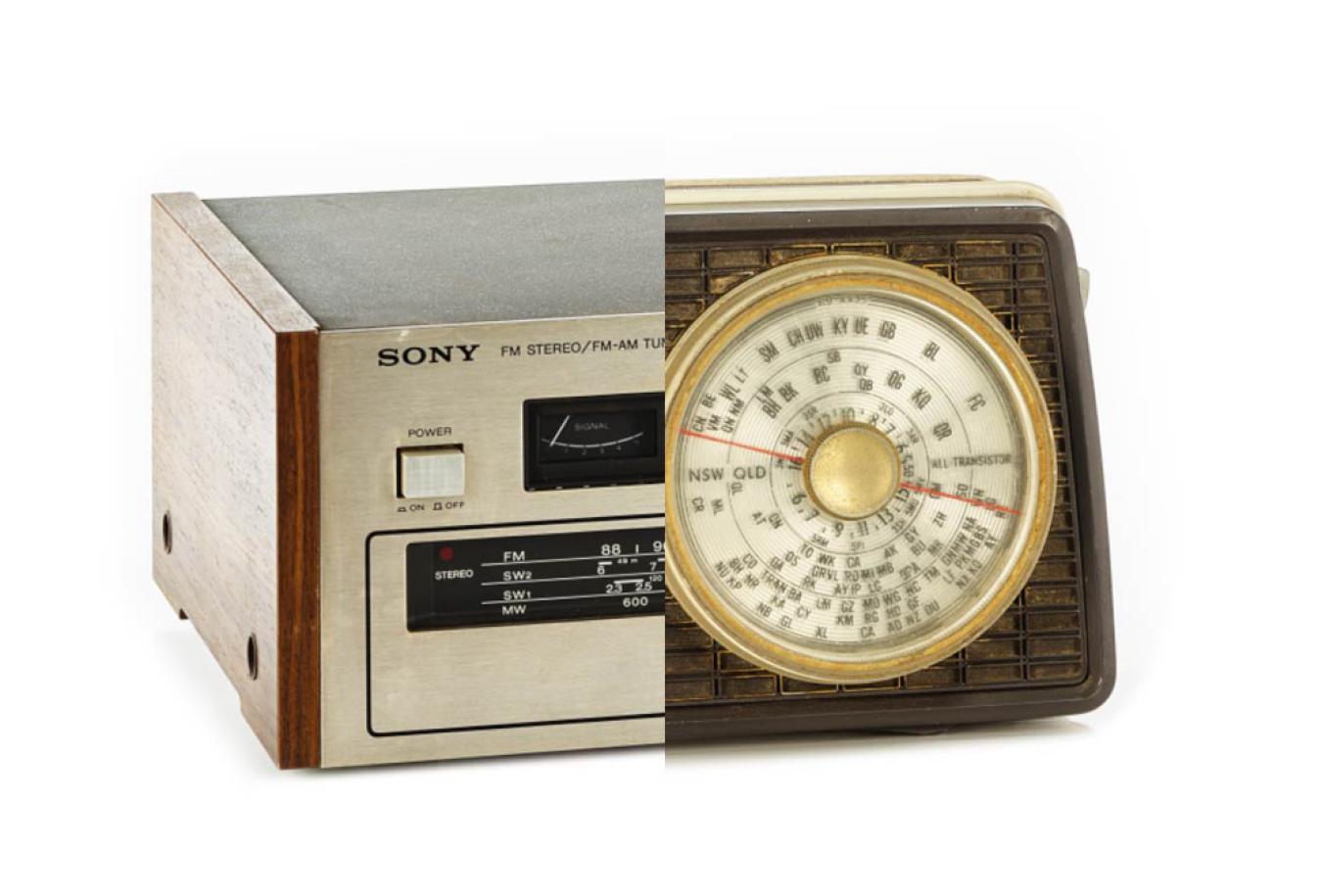
Plan your visit
Visit the NFSA Canberra
Our opening hours
Around the web
- Facebook Canberra
- YouTube NFSA
- YouTube NFSA Films
1800 067 274 [email protected] Contact us
Email sign up
Never miss a moment. Stories, news and experiences celebrating Australia's audiovisual culture direct to your inbox.
Support us to grow, preserve and share our collection of more than 100 years of film, sound, broadcast, games – priceless treasures that belong to all Australians.


Australian Circus Shows, Performers and History
This collection celebrates Australia's rich history of circus and carnival performers.
It includes footage of Wirth's Circus, which entertained audiences for over 100 years, as well as the Flying Fruit Fly Circus and Circus Oz.
There is also remarkable footage of a police motorcycle chariot race, country musician Smoky Dawson's knife throwing act, acrobats, animals, clowns – and even a cockatoo circus!
The first recorded circus entertainments were given in Sydney in 1833 by two tightrope walkers, one of whom was a former convict. Outside Sydney, Radford's Royal Circus opened in Tasmania in 1847.
Main image: Wirth's Circus Parade (Lord Mayor’s fund), 11 April 1941. Call number Home and Away – 30713 . From the collections of the State Library of NSW.
Note: some of these clips feature animals performing in a circus or carnival context. The NFSA does not endorse the use of animals for entertainment purposes and presents these clips as part of Australia's audiovisual history.
WARNING: this collection may contain names, images or voices of deceased Aboriginal and Torres Strait Islander people.
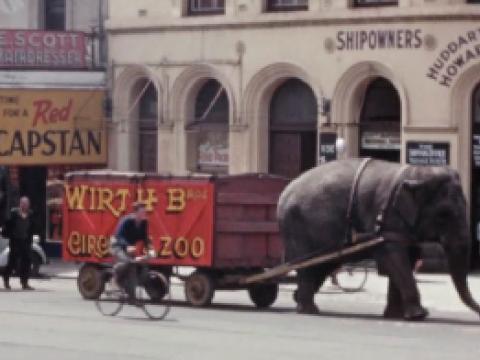
Behind The Big Top
Wirth's Circus arrives at Geelong and prepares for a performance. The footage shows the circus being transported on train carriages and then being hauled by elephants along the main street, past the office of shipping company Huddart Parker.
Then the erection of the big top, performing elephants and horses, clowns, woman lion tamer Madame Kovar and trapeze artists.
Wirth’s Circus was Australia’s largest and most prestigious circus company. For 80 years Wirth’s was billed as Australia’s own ‘Greatest Show on Earth’, and was a huge travelling circus with an international reputation.
They embarked on significant world tours and were the first Australian circus to perform in England. They boasted an exotic menagerie of animals, ‘beautiful and marvellously trained’, and recruited many star attractions from Europe and America, ranging from Captain McCloud’s Wild West Show (1905) to the Rioguku Japanese Troupe (1917).
This home movie footage was shot by Phillip J Phillips and is part of a much larger collection of home movies recording the history of Wirth's Circus.
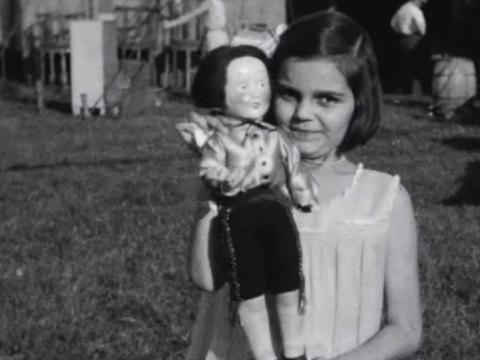
Con Colleano home movie: circus preparations
Australian-born and world famous tightrope circus artist Con Colleano (Cornelius Sullivan, 1899 –1973) features in this home movie of informal Ringling Bros and Barnum and Bailey Combined Circus 'backyard' scenes.
The segment begins with footage of Con rehearsing his famous cape dance. Circus equipment is unloaded on the lot and a menagerie of circus animals and performers are seen preparing for the grand parade.
Performers enter and leave the big top during the performance. A clown hangs up clothing on a line. Con is seen dressed in a dapper, pin-striped suit smoking a cigarette near a circus wagon. A young girl with her doll smiles for the camera. John Ringling (circus boss) pays the show a visit.
Con performs another cape dance in full costume and is joined by his wife 'Big' Winnie. The final shot is of Con’s sister, 'Little Winnie' with her hair in ringlets, who is joined by some fellow female performers.
Con was inducted into the Circus Hall of Fame, Sarasota, Florida in 1966. He is in the Guinness Book of World Records as being the first person to ever successfully attempt a forward somersault on a low-wire tightrope.
The location of this footage is uncertain, however shots of ‘The Alamo’ appear on the same film reel so it is possibly in San Antonio, Texas.
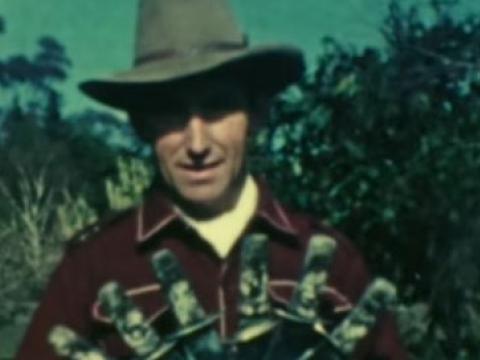
Smoky Dawson's thrilling knife throwing
Smoky Dawson (Herbert Henry Brown, 19 March 1913 – 13 February 2008) shows off his knife-throwing skills with an unknown man serving as his brave assistant.
Dawson is best known as an Australian country music performer who created the persona of the 'happy-go-lucky singing cowboy', however he was also an expert knife and double-headed axe thrower and performed his act at rodeos, circuses and country shows.
This film was shot in a Melbourne park by Frank 'Tex' Glanville. Glanville was a renowned Australian vaudeville performer who specialised in rope spinning and juggling between approximately 1928 and 1965.
He made a range of home movies on 8mm film featuring his vaudeville friends. These are preserved as part of the home movie collection at the NFSA.
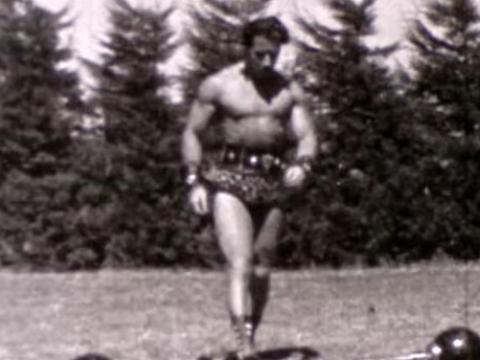
Nothing stops 'The Mighty Apollo'
Strongman Paul Anderson, AKA 'Young Apollo' or 'The Mighty Apollo', performs a range of feats of strength.
Stone blocks are crushed on his body with sledgehammers, he is run over by a car and he also performs his famous 'teeth grip' in which he pulls a motor vehicle with his teeth. In one instance the car is also loaded with people to add extra weight.
'The Mighty Apollo' wears a traditional strongman costume, leopard-print tight shorts with belt, gladiator sandals and leather hand cuffs.
This film was shot by Frank 'Tex' Glanville in an unidentified Melbourne suburban street. The little boy seen on top of the car bonnet is his son, Grahame Glanville.
Glanville was a renowned Australian vaudeville performer who specialised in rope spinning and juggling between approximately 1928 and 1965.
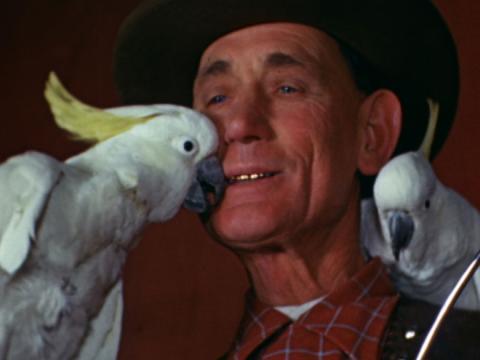
Cockatoo Circus
This Cine Service production from 1949 shows Australian stockman Peter Miller with his well-trained sulphur-crested cockatoos performing a remarkable series of tricks, including the cockatoo merry-go-round, high wire and piano playing.
The cockatoos performed in front of packed houses of mesmerised children at the Melbourne exhibition building.
Learn more about Australian acts in the Circus curated collection.
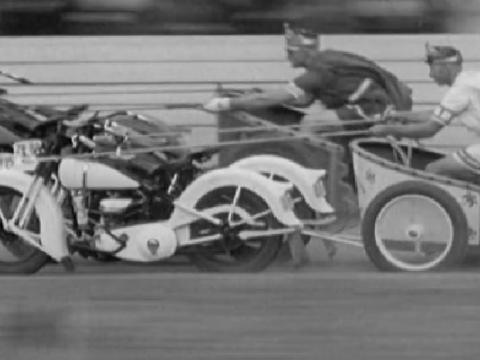
Fifty Thousand See Great NSW Police Carnival
The 1936 NSW Police Carnival, featuring a parade with the 'boys in blue' and stunts involving dogs, horses and a motorcycle chariot race, Ben-Hur style, which needs to be seen to be believed!
From Movietone News , 7 March 1936.
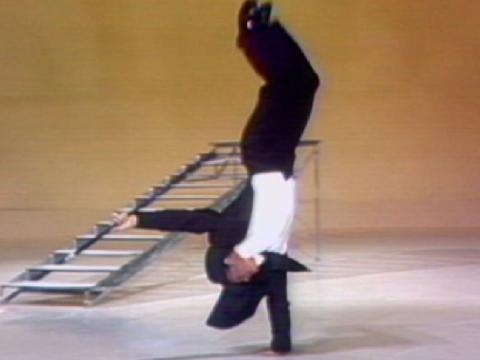
Acrobat Patrick Bradford, Sole Brothers' Circus
Acrobat and Sole Brothers' Circus performer Patrick Bradford appears on The Mike Walsh Show in 1979 (Ep. 9203).
Bradford was the fourth generation of a Belgian circus family.
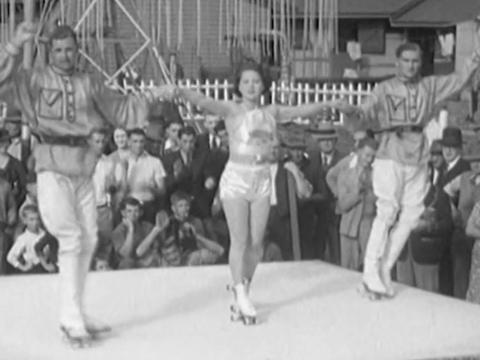
Carnival time finds daredevil rehearsing acts
International rodeo riders practice for the Royal Sydney Show in 1936.
We also see a team of five Cossacks giving a display of skilled horse riding and three 'reckless Russian skaters' rehearsing their performance before a small crowd on an elevated stage.
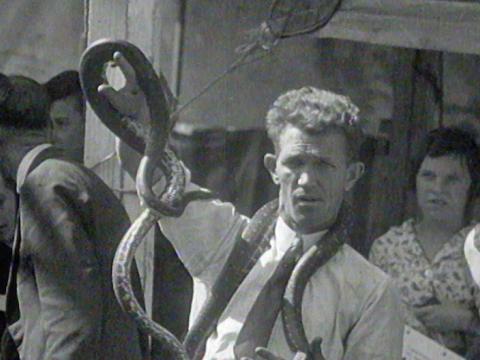
Sydney Royal Easter Show attractions
This newsreel footage shows the diverse range of attractions at the Sydney Royal Easter Show in 1933. There is no narration; instead, ambient noise from the show fills the soundtrack.
We see glimpses of the often bizarre sideshow entertainers as well as favourites like the giant merry-go-round, Ferris wheel and other rides.
The first Sydney Royal Easter Show was held in 1823 by the newly formed Agricultural Society of New South Wales. In 1881 land was provided for the Royal Agricultural Society at Moore Park where the show was held for 116 years before relocating to a new showground within the Sydney Olympic Park precinct at Homebush Bay.

Bicycle wizard Jimmy Constanto, Sole Brothers' Circus
The 21-year-old Sole Brothers' Circus performer Jimmy Constanto performs on The Mike Walsh Show in 1979 (Ep. 9203).
Walsh introduces him as ‘the wizard of the silver bicycle’ and Constanto performs a variety of acrobatic two-wheeled tricks and stunts.
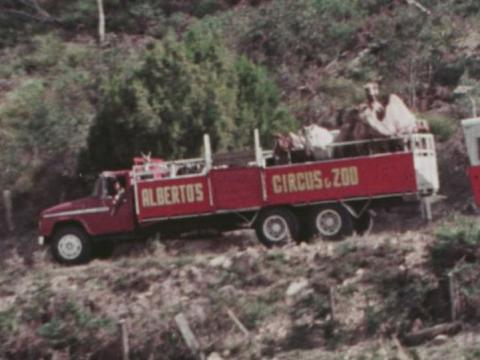
A Big Country: Alberto's Circus on Tour
This excerpt from the ABC program A Big Country covers the Tasmanian leg of Alberto's Circus' travels across Australia. It's extraordinary seeing some of the animals in open trucks; the circus must have been quite a sight when it rolled into town to set up at local showgrounds.
It also gives an insight into the logistics involving in transporting a circus consisting of: five trucks, three caravans, ten monkeys, five ponies, four donkeys, three camels, two elephants, one tiger, one wolf and one llama.
For over 20 years, from 1968 to 1991, A Big Country was broadcast on prime-time ABC television, winning awards and high ratings. This clip is a wonderful example of the kind of short documentaries the ABC made, highlighting aspects of Australian life, particularly from rural regions.
The segment gets up close with the circus and gives us a real sense of the long distances they travelled to perform for the public. Despite the decades since this story aired, it's still thoroughly engaging.
Note: the NFSA does not endorse the use of animals for entertainment purposes. This film must be understood in its historical context.
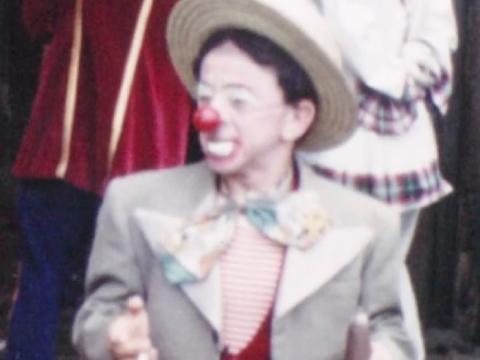
Wirth's Circus arriving and performing
This 8mm footage of Wirth's Circus was shot by unknown American tourists who filmed in Australia and New Zealand in the 1950s.
The footage shows the circus unloading their gear from a train with the help of the famous Wirth's Circus elephants. Then the crew undertake the arduous work of erecting the big top.
Behind-the-scenes footage show clowns, costumed elephants and horses. Black-and-white footage shows the elephants and trapeze artists performing.
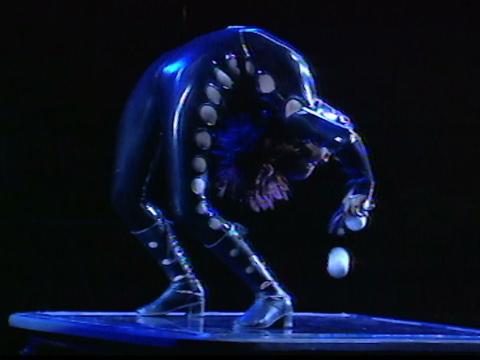
Circus Oz at Melbourne Town Hall
This short Nine Network news item heralds the arrival of Circus Oz for a season of performances at Melbourne Town Hall in 2002.
Founded in 1978 in Melbourne, Circus Oz is an animal-free troupe that incorporates circus acts, theatre and music.
The company is also known for its strong social justice agenda, including women's rights, land rights for Australia's First Peoples and strong opposition to the detention of asylum seekers.
Circus Oz has performed in 27 countries across five continents and has broken box-office records at the Edinburgh Fringe Festival.
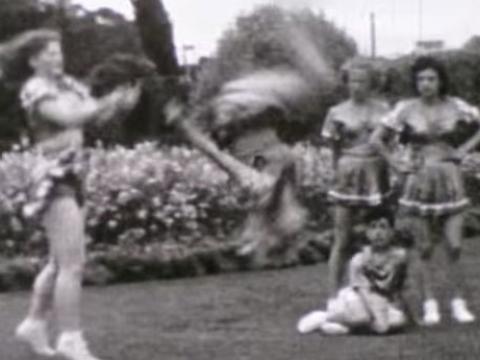
Evelyn Albrecht and her young acrobats
Acrobat, dancer and performer Evelyn Albrecht poses for the camera. The troupe of young female acrobats then perform routines in a Melbourne park.
This film was shot by Frank 'Tex' Glanville, who uses in-camera slow and fast speed changes in this film to highlight the skilful twists and turns undertaken by these expert acrobats.
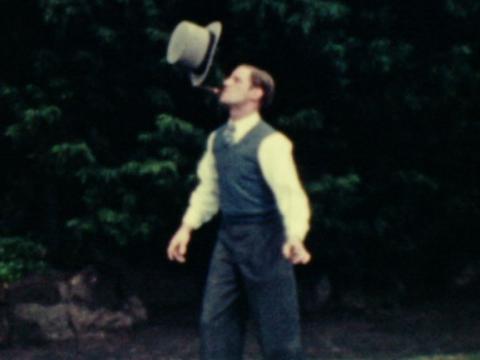
Elimar, the 'juggling genius'
Juggler and tightrope walker Elimar Clemens Buschmann performs his famous tennis-racket trick, hat tricks and juggling routines with clubs, balls and rings.
Buschmann was a genius juggler as well as a tightrope walker. He was born in Germany and arrived in Australia c.1939, escaping the Nazi regime, where he was interned as an enemy alien.
He spent some of the late 1940s in the US and even toured with the Harlem Globetrotters as the half-time entertainment. Around this time he also married his first wife, a Tivoli ballet performer named Dawn Butler.
In the mid-1950s Elimar began a partnership with Louise Matheson, who was then in the chorus of several JC Williamson's productions. She assisted him with his juggling acts and they formed a double act after some work in local vaudeville musicals, and toured all over Asia and Europe.
Elimar was billed as the King of Jugglers and she was 'Louise, the Queen of Song'. He juggled, she sang, and then he performed on the slack wire.
This film was shot in a Melbourne park, c.1950 by Frank 'Tex' Glanville. Glanville was a renowned Australian vaudeville performer who specialised in rope spinning and juggling between approximately 1928 and 1965.
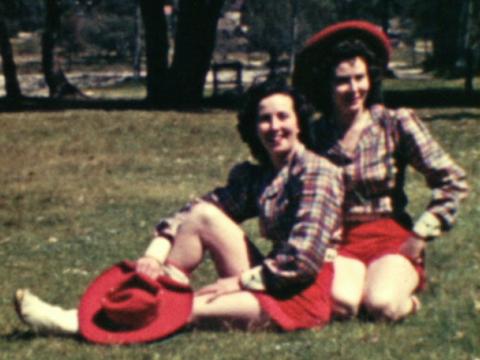
The Loretta Twins: lasso cowgirls and acrobats
The Loretta Twins perform lasso and skipping tricks as well as acrobatics, wearing matching cowgirl outfits.
The film was shot in a Melbourne park by Frank 'Tex' Glanville who created the slow-motion sections of the film in-camera.
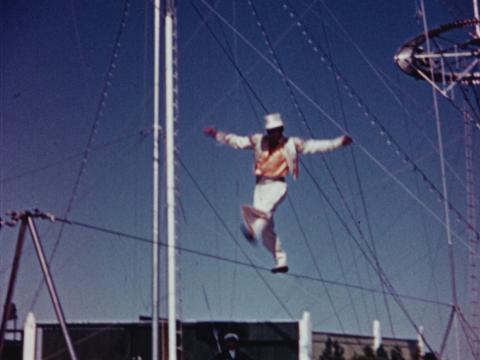
Colleano on Tightwire, Rehearses in Arena: The Wizard of the Wire
Dressed in Spanish matador costume with flowing crimson and white cape, Con Colleano commences his elaborate Spanish-flavoured circus routine. High upon the tightwire, he dances, bounces, twirls and balances, before executing a backward somersault that reveals crimson pants beneath his outer costume. Summary By Poppy De Souza
Learn more about Con in this article and see more of his work in the Circus curated collection.

Wirth's Circus: Behind the Big Top
The film begins with Wirth's famous circus elephants being dressed in their costume rugs. This is followed by a menagerie of animals: horses, ponies, zebras, more elephants and a caged lion.
The footage shows George Wirth with two women and another shot that shows him with his 16mm motion picture camera in hand – it is assumed that his brother Philip Wirth is filming him. We see a number of performers, including a dancer and a very tall and very short man.
In one scene, all the circus performers and animals are gathered out the front of the tent for a formal photograph; the photographer can be seen setting up his camera at the edge of the frame. The film ends with footage of a performer wearing a Wild West inspired costume holding a gun.
This footage is teamed with a recording of Philip Wirth playing the tin whistle, originally recorded on lacquer disk and digitised by the NFSA. It is unknown what year this music was recorded, however it is known that Philip Wirth took up playing the tin whistle in his older age and would often play it in the circus ring during performances.
Wirth’s Circus was Australia’s largest and most prestigious circus company. For 80 years Wirth’s was billed as Australia’s own ‘Greatest Show on Earth’, and was a huge travelling circus of international standard and reputation.
It was the sons and daughters of Johannes and Sarah Wirth, of German origin, who formed the circus: John, Harry, Philip, George, Marizles, Mina and Madeline.
The Wirth brothers began performing with their father as a travelling band though they soon advanced their show into a variety troupe and established themselves as a small circus by 1882. The circus grew rapidly; extended family featured as artists, they embarked on world tours, travelled Australia extensively, boasted an exotic menagerie of animals and recruited star attractions from Europe and America.
It was Phillip and George Wirth that continued to manage the circus as Wirth’s Bros Circus from the 1910s. George Wirth retired in 1930, though Philip Wirth and his extended family continued running the business up until its demise in 1963.
The NFSA currently holds approximately 50 x 16mm home movies that document the Wirths' private life, circus life and performances from aproximately 1926 to the 1950s. They primarily cover the period that Philip and George managed the circus.
The majority of the films are thought to be shot by George Wirth, who became a director of Pagewood (Film) Studios after his retirement in 1930.
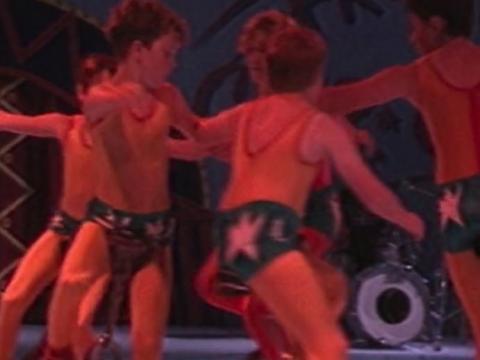
Flying Fruit Fly Circus
This item from GMV6 News 1989 records the 10th anniversary performance of the Flying Fruit Fly Circus and outlines its future funding concerns.
The Flying Fruit Fly Circus is located on the Murray River in the twin cities of Albury-Wodonga on the Victoria-New South Wales border. The circus started operations in 1979 and is the only full-time circus school for young people aged 8–19 in Australia.
In its long history the company has toured internationally to Asia, Europe, Canada and the US and performs regularly at major Australian festivals. They also made a special appearance at the 2000 Sydney Olympics Opening Ceremony and Cultural Festival and the closing Ceremony of the XVIII Melbourne Commonwealth Games in 2006.
The circus is also currently the resident youth circus at Sydney Opera House.
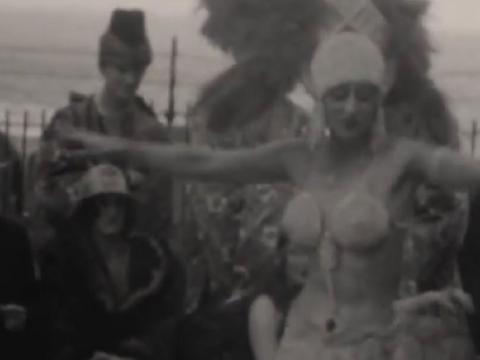
Wirth's Circus: At Ocean View, Coogee
Home movie footage of the Wirth family at work and play. Performers and family members in costume perform routines for the camera.
We see George Wirth and Philip’s wife Alice Wirth (nee Willis) arrive arm in arm; they are seated and entertained by an exotic troupe of performers. The young woman seen toe-dancing and wearing a tutu is Philip and Alice’s fourth daughter, Madeline Wanda Wirth.
This film was shot on the grounds of Philip Wirth’s famous residence, ‘Ocean View’, which was his home in Coogee. The grand mansion overlooks the Gordon’s Bay and Coogee Bay area of the Sydney coastline and was built in 1926 by Philip.
His wife Alice and seven children lived there and the home stayed with the extended Wirth family up until 2009 when it was sold. Philip Wirth (b.1864) died aged 73 at ‘Ocean View’ in 1937.
Later in the clip we see Philip Wirth, white cockatoo perched on his shoulder, with some of his daughters (possibly, Eileen, Doris & Madeline) walking out the front of his home.
It is rumoured that one of the Wirth’s Circus most famous elephants, Alice (Princess Alice), is buried on the grounds. She was a star attraction with the circus and in 1898 during a tour in England, it was said that the Prince of Wales rode her before her became King Edward VII.
This footage is teamed with a recording of Philip Wirth playing the tin whistle, originally recorded on lacquer disk and digitised by the NFSA (Side A: Cuckoo / Side B: Scottish Medley). It is unknown when this music was recorded however it is known that Philip Wirth took up playing the tin whistle in his older age and would often play it in the circus ring during performances.
It was the sons and daughters of Johannes and Sarah Wirth, of German origin, that formed the circus: John, Harry, Philip, George, Marizles, Mina and Madeline.
The Wirth brothers began performing with their father as a travelling band though they soon advanced their show into a variety troupe and established themselves as a small circus by 1882.
The circus grew rapidly; extended family featured as artists, they embarked on world tours, travelled Australia extensively, boasted an exotic menagerie of animals and recruited star attractions from Europe and America.
The NFSA currently holds approximately 50 x 16mm home movies that document the Wirths' private life, circus life and performances from approximately 1926 until the 1950s. They primarily cover the period that Philip and George managed the circus.
Notes by Tara Marynowsky
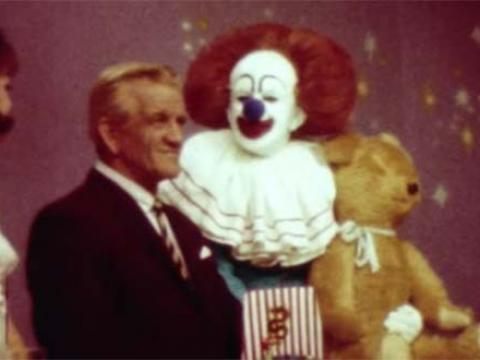
Hal Turner as Bobo the Clown
This clip from Hal Turner's home movies includes footage of him performing as Bobo the Clown with his daughter Gail as Lenny the Lion. The footage also shows his wife, Pearl, setting up a stall at the Adelaide Show and Turner celebrating his wedding anniversary.
As Bobo, Hal Turner first appeared in an ensemble cast on NWS9’s children’s program, The Channel Niners . In addition, Turner also wrote, produced and acted in the station’s Christmas pantomimes including Cinderella , Jack and the Beanstalk and Aladdin . He was also hosting two radio programs as Bobo and wrote a newspaper column. Bobo quickly became a household name, first in Adelaide and then nationally.
Turner left NWS9 and began a five-month publicity campaign of public appearances, radio interviews, charity work and special events for the soon to be launched SAS10. Meanwhile at NWS9, Bobo’s old station, Rex Heading was developing a new character, Humphrey B Bear. The iconic children’s TV character first appeared on Here’s Humphrey on 24 May 1965 and ran until 2008 as the second-longest-running children’s TV program in the world.
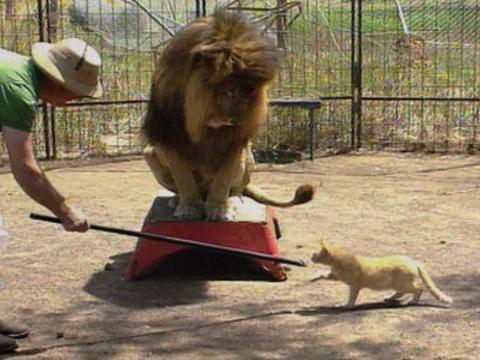
The Last Circus?: Training circus animals
We see lions being trained. Trainer Stafford Bullen says the same techniques are used to train lions and tigers and domestic cats.
Summary Damien Parer
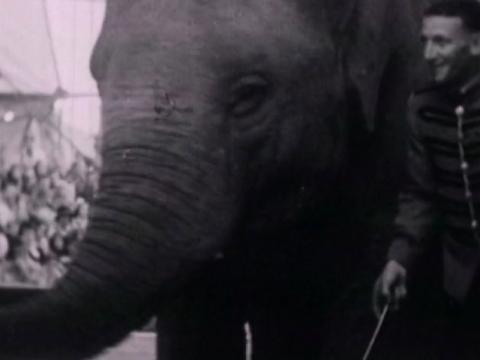
Behind the Big Top: Inside the sawdust arena
The procession of performers and circus acts passes by the camera to enter the big top arena including horses, clowns and elephants. Some of the acts are filmed including a female lion tamer, a cycling clown, performing elephants, and barebacked horse riders. A boy from the audience is harnessed and tries to ride the horse. The clowns join in the fun as he flies around the circle and steals a man’s cap. Summary by Poppy De Souza
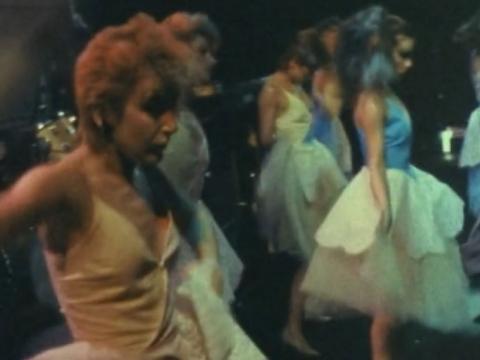
Cold Chisel Last Stand: Circus Animals Tour
This is an excerpt from the music documentary Cold Chisel Last Stand featuring producer Mark Opitz discussing the Circus Animals concert tour and how Cold Chisel were a band who loved to give back to their fans.
The band went to great expense for the Sydney shows, which included trapeze acts and circus animals under a big top.
The clip starts with some unexpected footage of circus performers and dancers to a backdrop of Ian Moss playing his guitar before cutting to an image of the cover of the album and the circus tent where the band performed.
The montage is very effective in setting up the interview with record producer Mark Optiz, appropriately seated by a mixing desk in a recording studio. It's a 'thumbnail' of an interview but sufficient in making the point that Cold Chisel never forgot who their fans were.
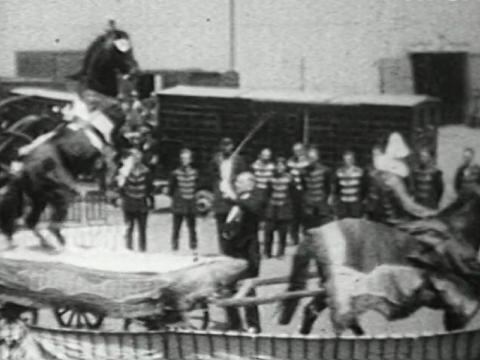
Wirth's Circus Film: Philip Wirth and Earl Dudley
A fixed camera positioned on the edge of an outdoor arena captures ringmaster and circus proprietor Philip Wirth rehearsing with his trick pony, Earl Dudley. The pony is led around the arena on a horsedrawn platform as Wirth instructs it to perform various tricks including bowing, jumping, turning, kneeling, sitting and rearing. Circus wagons and a small crowd of circus employees can be seen in the background. At the end of the act, Earl Dudley is led out of the arena and Wirth bows to the camera before following behind. Summary by Poppy De Souza
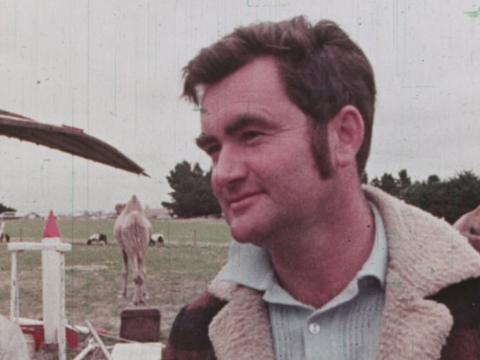
A Big Country: The Appeal of Alberto's Circus
This excerpt from the ABC program A Big Country traces the very start of Alberto's Circus and Zoo back to the late 1800s when the Perry family swapped their western Queensland pub for a bullock team.
From humble beginnings they created one of Australia's oldest and most travelled circuses which was passed down through the family.
The segment gets up close with the circus owners, who offer refreshingly candid and off-the-cuff responses to the journalist's questions. The footage of the travelling convoy also gives us a real sense of the long distances they travelled to perform for the public, often in hot and dusty conditions. The clip is thoroughly engaging for the insights it gives into the life of a travelling circus.
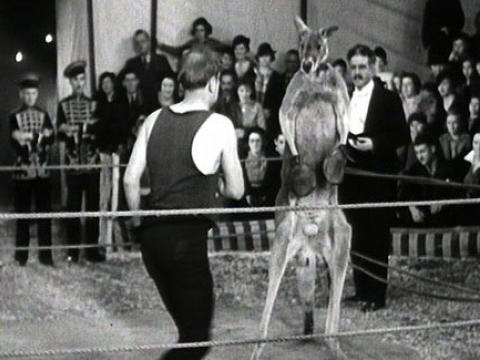
Orphan of the Wilderness: Chut's Revenge
Shorty McGee (Harry Abdy) has punished his prize attraction, Chut the boxing kangaroo, by denying him water for two days. In the ring, Chut’s thirst and his hatred for the whip-wielding McGee boil over. Chut attacks the drunken McGee, inflicting serious wounds on the trainer. In the ensuing chaos, Chut escapes the circus. Margot (Gwen Munro) rushes to warn Tom Henton about what has happened. Summary by Paul Byrnes
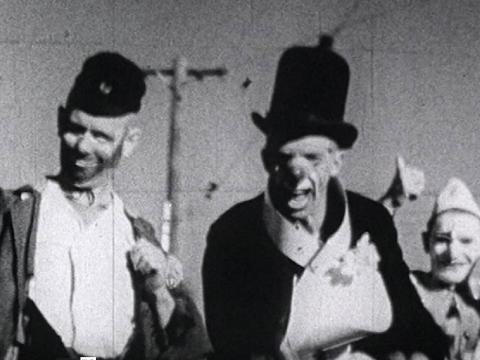
The Circus Comes To Town: The Circus Parade
The members of Wirth’s Circus and Zoo parade down the main street as a large crowd looks on. The parade includes elephants, clowns, performers on horseback and caged animals. In another shot, Shetland ponies are led by boys over a bridge towards the showground. Intertitles are used to describe the action. Summary by Poppy De Souza
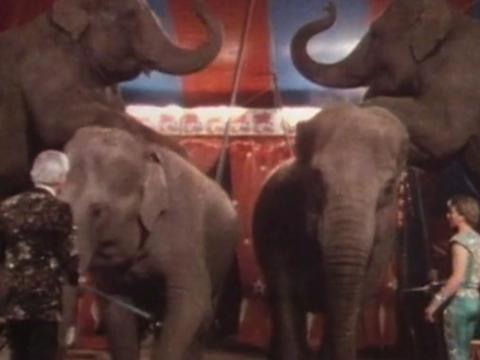
The Last Circus?: Circus Song
A song, 'The Last Circus’, plays under a montage of circus scenes, including clowns, acrobats, animals performing and kids reacting. Summary by Damien Parer
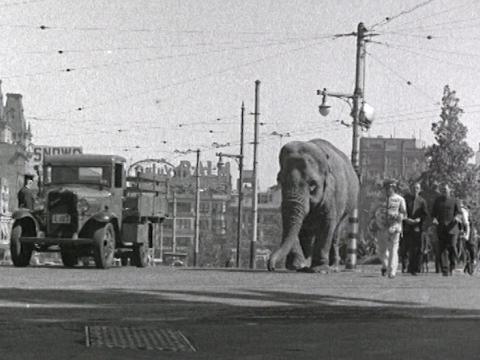
Alice has to walk home
This silent newsreel clip shows Princess Alice, the most beloved and famous elephant of Wirth's Circus. It's unclear whether the truck has broken down or if Alice in unable to climb back on board. Either way, she has to walk home.
Princess Alice was bought at auction in New Zealand in 1906 for a record sum before being transported to Sydney. Originally she gave rides for children in Wonderland City, Tamarama.
When Wonderland closed in 1912 she was acquired by Philip Wirth and walked to Wirth's home in Coogee which was still under construction. Alice was a local celebrity in Coogee, delighting people on her evening walks along the beach.
It was with great sadness that Alice was eventually euthanised in 1956 and was said to have been buried in the backyard of the Wirth family home.
This footage is from Cinesound Review No. 292 .
More to explore
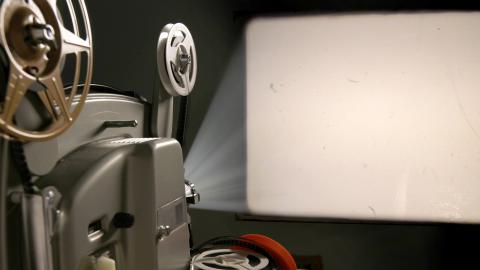
Home movies collection
This collection includes highlights of some of the almost 6,000 unique home movie titles held by the NFSA.
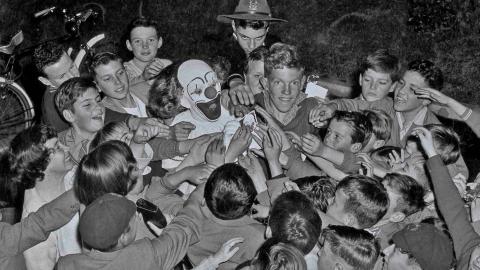
Bobo the Clown Collection
The first program broadcast on Adelaide television station SAS10 on 26 July 1965 was The Bobo Show , starring Charles ‘Hal’ Turner as Bobo the Clown.

Vaudeville friends
Tara Marynowsky explores the home movies of vaudeville performer and amateur filmmaker Frank 'Tex' Glanville.
The National Film and Sound Archive of Australia acknowledges Australia’s Aboriginal and Torres Strait Islander peoples as the Traditional Custodians of the land on which we work and live and gives respect to their Elders both past and present.
Enter the NFSA Our Statement of Reflection

- ABOUT NICOLE
- The Cedar Tree
- Stone Country
- An Uncommon Woman
- The Great Plains
- Sunset Ridge
- Absolution Creek
- A Changing Land
- The Bark Cutters
The golden age of the travelling circus
This circus launched the careers of major circus performers and owners, including Golding Ashton, later known as ‘James Henry’ Ashton. A founding father of one of the great Australian circus families, it was Ashton who took to the bush. Having sailed from Tasmania so that his troupe could perform in Melbourne in 1849, they were refused the right to perform by authorities worried that the event may disrupt the public and cause mischief.
Ashton wasn’t going to be beaten. With the help of an Aboriginal tracker he led his troupe through the bush carrying all their possessions by packhorse. Eventually they reached Sydney and it was here that they gave equestrian exhibitions in a makeshift ring near present-day Central Station.
The popularity of circuses grew quickly. These travelling shows reached distant towns, remote shearing sheds and mining camps. In a time when entertainment options were non-existent in some places and many couldn’t read, the circus was a great boon. Early circuses supported the bush. They helped with the construction of vital services such as schools and hospitals and even our bushrangers usually waved traveling circuses on. Such was the case with Thunderbolt and the Wirth Brothers. I used the Wirth Bros circus as a basis for my research for An Uncommon Woman , and could easily understand how popular these shows were in the outback. This was entertainment. A major spectacle. It was a chance to go to town. To see friends. To be among the company of many. To have a chop-picnic (roasted meat – the term barbeque came later) and maybe some peanuts in a paper cone.
The golden age of the circus lasted from the 1850s until the early 1960s. But by the 1920s the circuses were already feeling the competition from the advent of the gramophone and the talkies (movies). The days of touring abroad were fast disappearing. It was the bush that kept the industry alive. And the travelling show business provided livelihoods for thousands of show people – entrepreneurs, performers, other employees, as well as freeloaders and dreamers, hopeful of seeing the world. It was the entertainment of the day and it wasn’t difficult imaging the excitement that a circus brought to the bush.
In the 1950s when the circus came to Moree , my father travelled the 116 kilometres from the property to attend with friends. He fell in love with a lion cub and offered the keeper fifty pounds for it, all the money he had with him at the time. The lion keeper refused, saying he couldn’t take anything less than one hundred pounds. Dad missed out on the baby lion, however years later he told me that he’d had this vision of a lion cub laying by his feet in the homestead dining-room. Probably not the best of ideas considering we were a sheep stud in the 50s. And so another family story led to an idea in a novel.
Share This Story, Choose Your Platform!
About the author: nicole alexander.
Related Posts
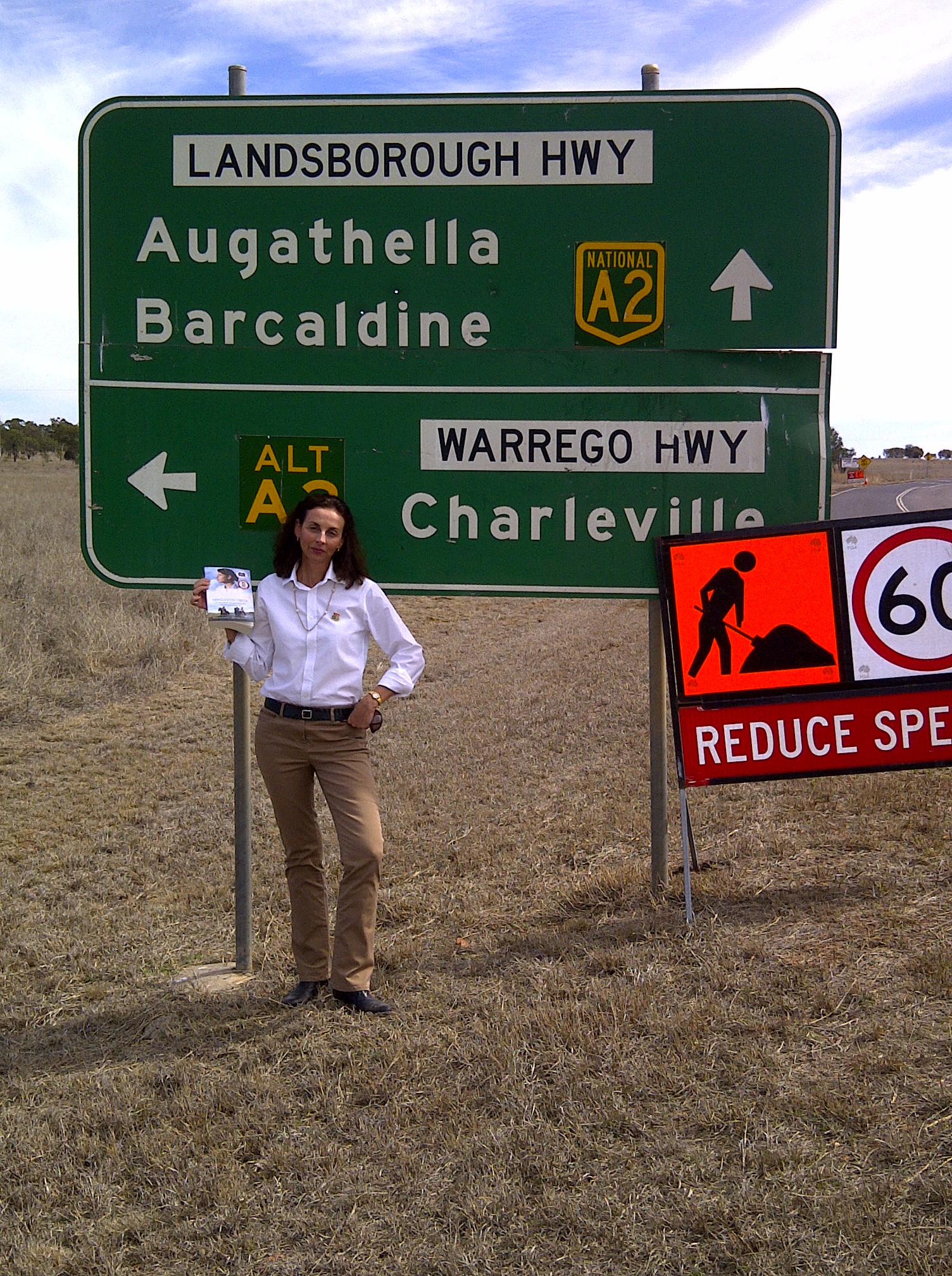
- Dabbling in Central West Queensland’s recent past.
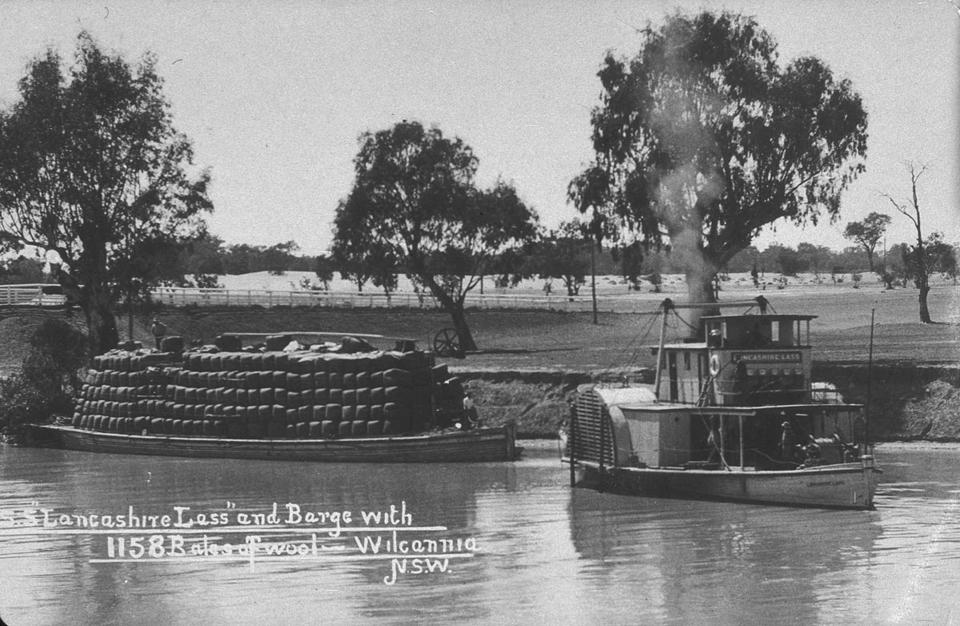
Paddle-steamers on the Murray-Darling River.
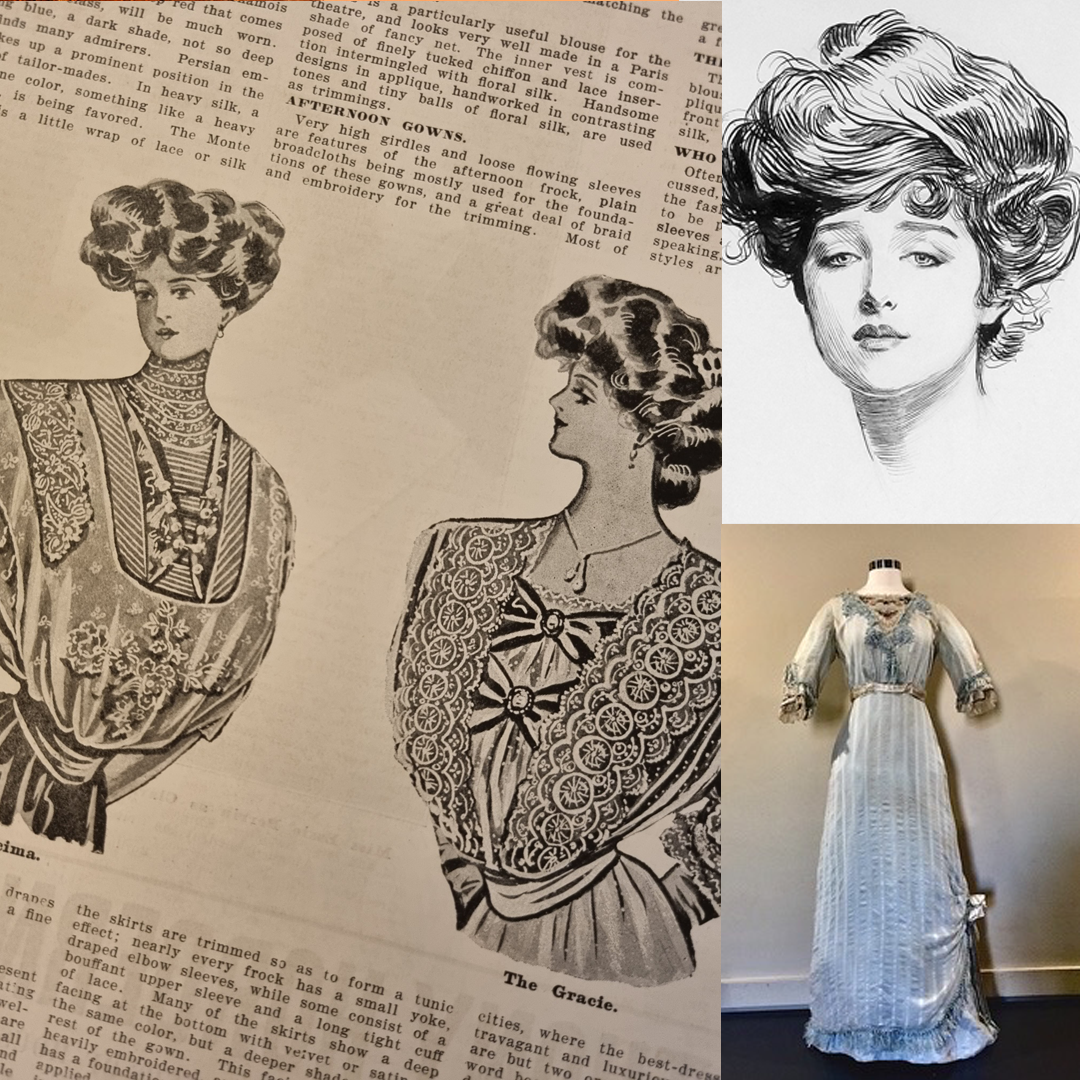
Being fashionable in the 1900s
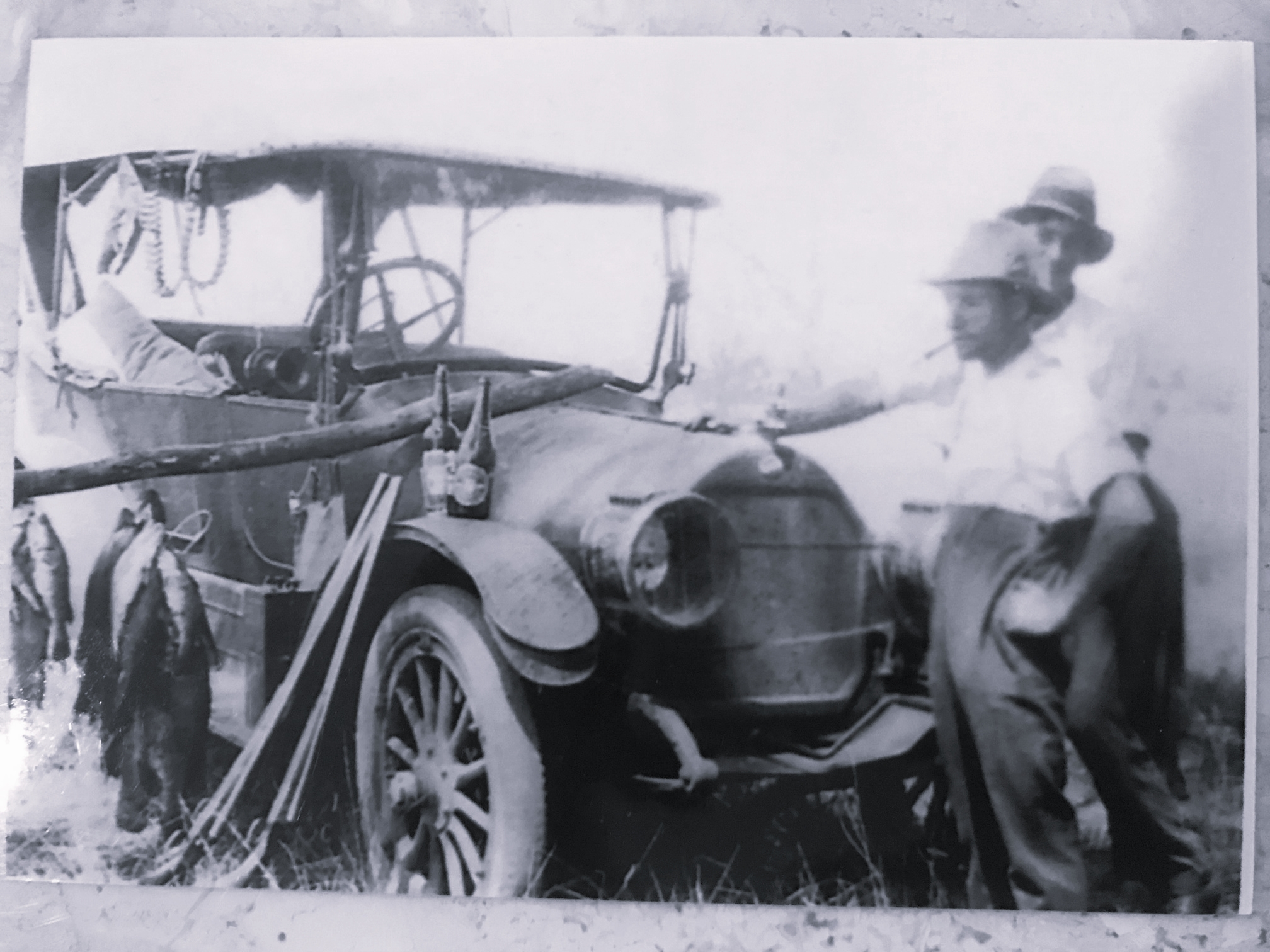
Conjuring fiction from family legend.
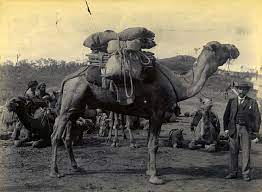
The Afghan Cameleers – Providing a vital service & yet the victims of prejudice
Leave a comment cancel reply, recent posts.
- Ode to finishing a novel – March 2024
- Conjuring fiction from family legend in ‘The Last Station’.
- A Bush Education
- State Parliament – Recognition in the Legislative Assembly

Circus Stories: Recollections from the oral history collection
The circus has a long tradition in Australia and it’s a spectacle that has evolved over time. From childhood memories of colour, noise and excitement through to adult recollections of time spent enjoying the delights of a travelling circus, the pleasures circuses have offered generations of Australians are undeniable. The Library’s oral history collection contains a wealth of recollections about circuses and their place in Australian hearts over the decades.
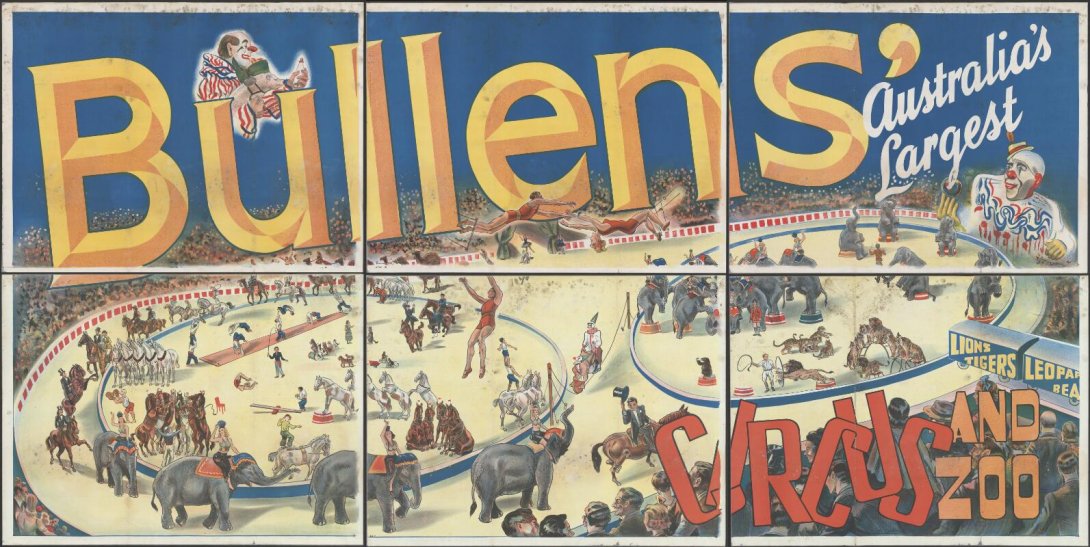
The longest running circus in Australia is Ashton Circus, which was founded in 1847 and still operates today. In an oral history interview with John Meredith, Douglas and Phyllis Ashton shared their recollections that dated back to the early twentieth century.
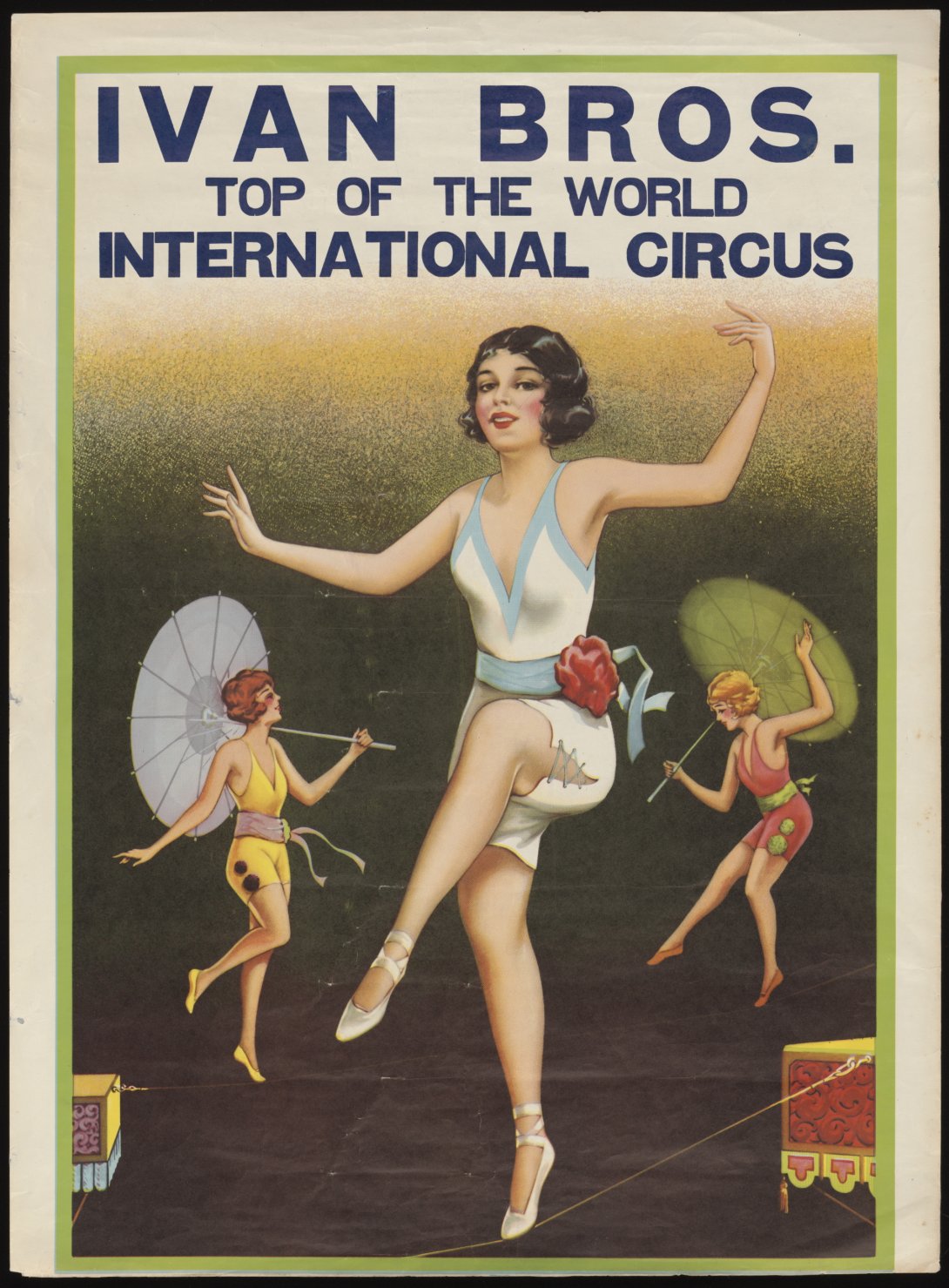
Douglas Ashton, the fourth-generation member to become involved with the Ashton Circus, saw the circus evolve from travelling by horse and wagon through to an event that traversed the country in motorised vehicles.
In 1993, he mused on the appeal of the circus to a wide audience. He declared:
'It’s good clean comedy. There’s nothing in it you’d be ashamed to take your children to see...with circus, it’s not like theatre where you’ve got to sit in your seat and be quiet...why we cater for the family man, for everybody.'
Many who have worked in circuses have pointed out the need to be multi-talented. Jim Dimo notes:
'I did work for a while as a hypnotist, as a musical clown. I was an acrobat, you know. I was doing just about anything possible to do. I was in many circuses where I did perform. You see, in the circus you just put another wig on and a little moustache or something like that and the people don't recognise you.'
Albert ‘Fuzzy’ Hearn , born in 1928, pointed out that in his view, being a clown was perhaps the most difficult role in the circus. Ironically, he’d initially chosen the role because he thought it might be one of the easiest to learn. He says:
'Everyone specialising in something…so I decided to take the easy way out and take clowning as my speciality. Little did I know that was the toughest one of the lot because when you stop and think about it, if you’re on a trapeze act, you can’t just clown the trapeze act. You have to learn to fly, you have to do everything the others do first and then you have to do the clowning. You have to do a difficult trick and make it look simple so it’s humorous. You know, that’s the thing. So you learn twice as much!'
Indigenous people have played a critical role in Australian circuses over time. Indeed, Con Colleano, whose mother was a Bundjalung woman and who was born in 1899, was one of the most highly paid circus performers of his time due to his innovation and ability, which included being the first person to successfully attempt a forward somersault on a tightrope.
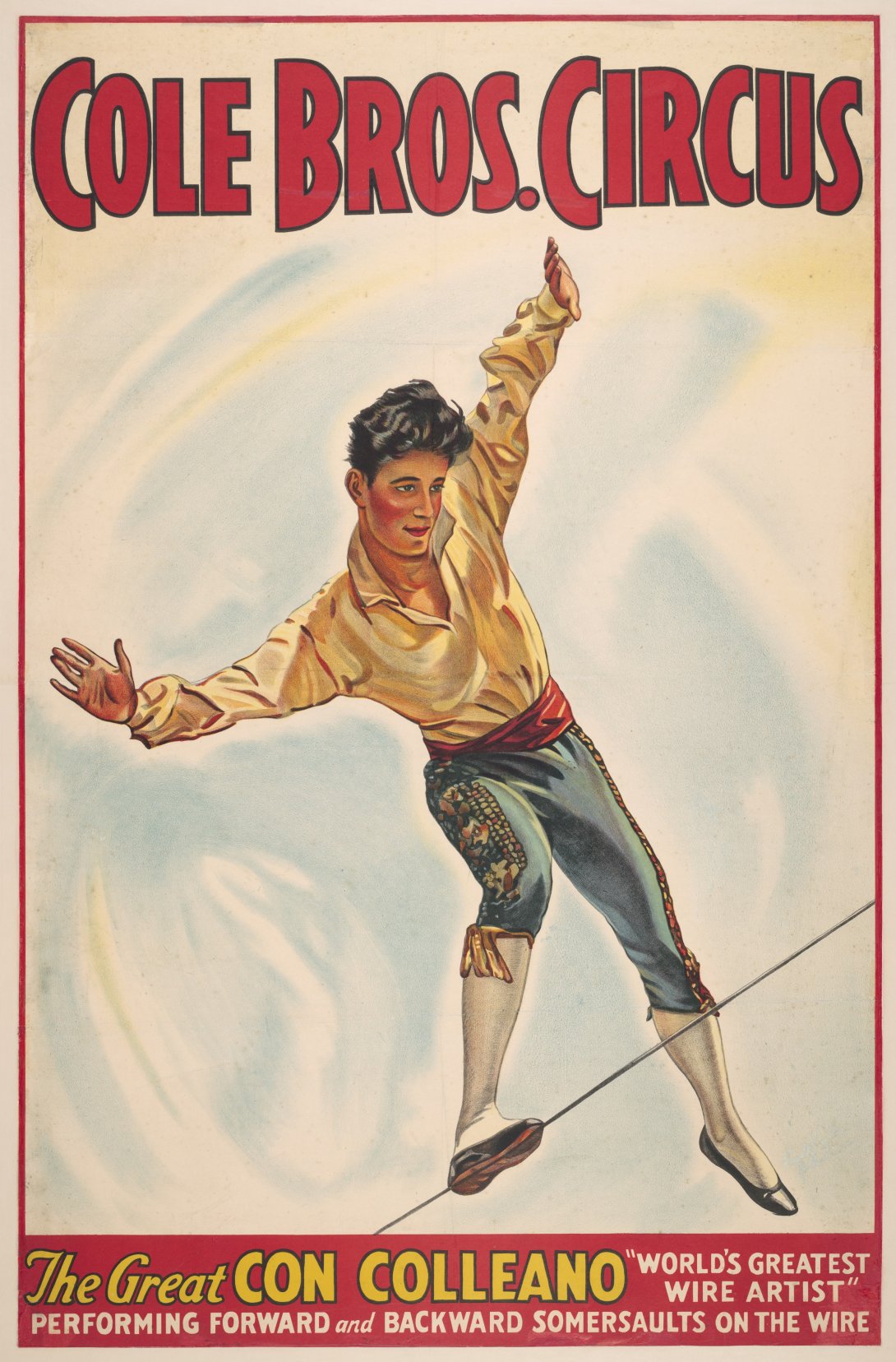
Con Colleano and his brother Maurice Colleano were interviewed together by Mark St Leon in 1951. Maurice was very keen to make clear Con’s extraordinary contribution to the circus world – not just in Australia but internationally. He said:
'Well, it all started right here in Australia…and when we sold out here in 1921, we all went to America, and of course Con became the star of the Ringling Brothers and Barnham and Baileys Circus, and recently that he's been featuring and starring with the Hopalong Cassidy Show…and he's a very big star in America.'
Dawn de Ramirez , an Aboriginal woman, was interviewed by Rob Willis in 2019 and remembers the quirks of fate that saw her take up a role as Buffalo Bill’s knife throwing assistant. She saw an advertisement in the paper for “three young lady typists required to travel to Australia and New Zealand with circus”. However, when she went to talk about the job, she found they’d all be taken but was offered the role of Buffalo Bill’s knife throwing assistant. She laughingly recalled that:
'There was a spinning wheel and you were on it, and spinning around, and he’d throw knives in between and everything, but it didn’t bother me. People would say later, you must have been terrified he’d hit you!’ No. It didn’t bother me in the least.'
The traditions of the circus have evolved over time in Australia. Exotic animals are no longer featured and women are welcomed as ringmasters. Companies such as the Flying Fruit Fly Circus, Australia’s national youth circus, trains a new generation of children and young people in circus skills.
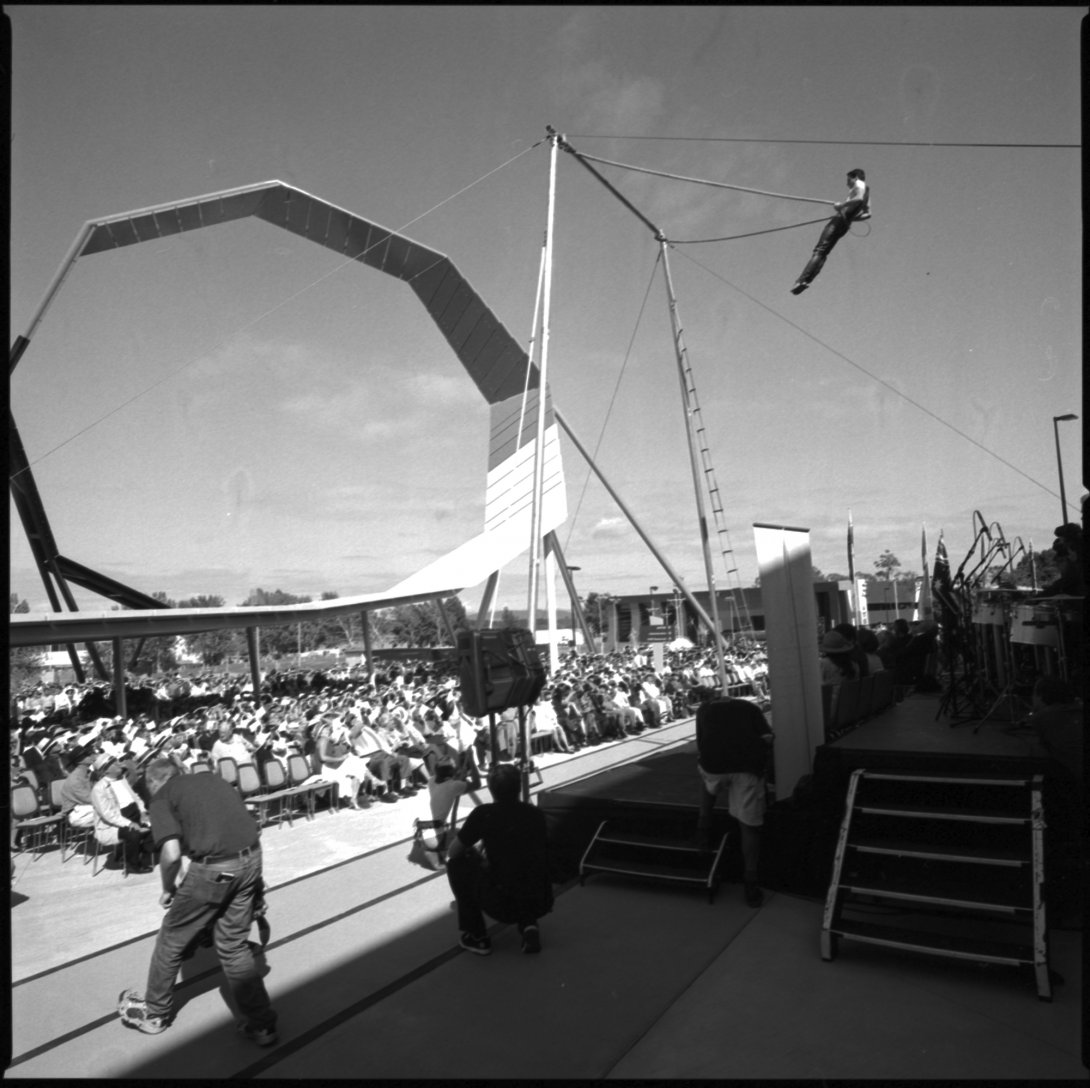
However, so much of what has drawn generations of Australians to the circus still remains. Whether it be the strength and impressive feats of trapeze artists and acrobats, the daring and talent of high wire walkers and the humour of clowns, the sheer escapism the circus offers still remains.
The National Library of Australia acknowledges Australia’s First Nations Peoples – the First Australians – as the Traditional Owners and Custodians of this land and gives respect to the Elders – past and present – and through them to all Australian Aboriginal and Torres Strait Islander people.
Cultural Notification
Australian Aboriginal and Torres Strait Islander people are advised that this website contains a range of material which may be considered culturally sensitive including the records of people who have passed away.

‘The Penny Gaff’: A New Historical Resource
Mar 16, 2021
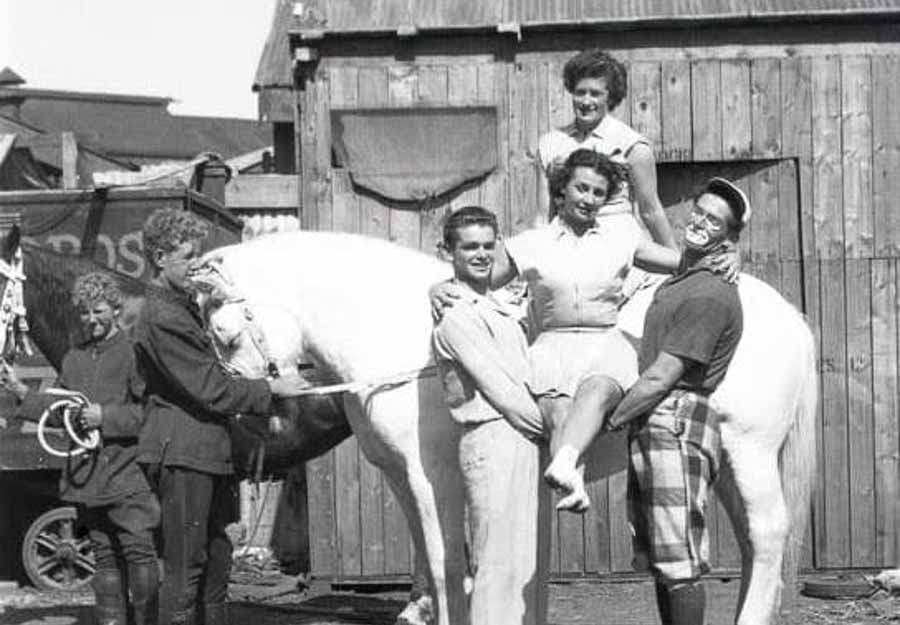
The circus is a rich and vibrant part of Australian cultural history that continues to flourish in many different forms today. Some of the most famous international circus stars of the twentieth century were Australian; at the height of the industry, 17 large circuses were travelling the country at once.
Dive into the lives, travelling routes, performances and more of our country’s most celebrated circus troupes in Mark St Leon’s new website, ‘The Penny Gaff’ , dedicated to the history of Australia’s circus and other travelling show people.
The Circus in Australia
From the early 1850s, travelling entertainers delivered to Australians an extraordinary diversity of culture … opera, minstrel, photographic, magic, bellringing, gospel singing, boxing, menagerie and carnival … However, the earliest demonstrable example of an Australian travelling show, and the most enduring, was the circus. – Mark St Leon, ‘The Penny Gaff’
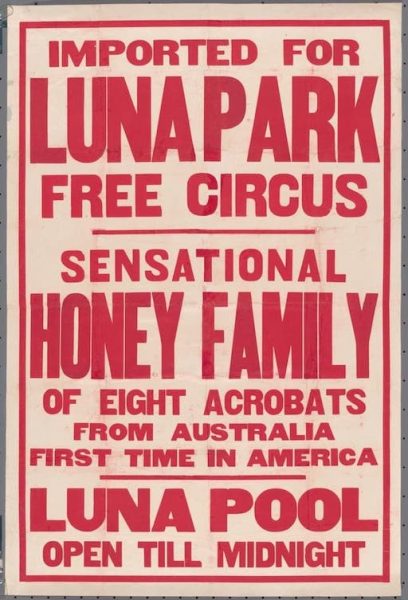
THE HONEY FAMILY, A BRANCH OF THE ST LEONS, PERFORMING AT CONEY ISLAND’S LUNA PARK, 1926. [IMAGE COURTESY ‘THE PENNY GAFF’.]
The circus as we know it today emerged in mid-eighteenth century London, where displays of trick horsemanship—on open-air circular riding tracks each known as a ‘circus’, from where the modern circus got its name—were combined with clowns, rope-walkers, and gymnasts by former decorated cavalryman, Sergeant-Major Philip Astley .
Circus did not burst onto the Australian scene until almost a century later, when Robert Avis Radford—the ‘Tasmanian Astley’—pioneered the first successful colonial circus venture in Launceston in 1847-49. From there, the industry took flight. Henry Burton first took the circus on the road from Sydney in 1851; early travel routes carried performers between goldfields then, later, further afield. So popular was the itinerant tented circus that even bushrangers waved them through, rather than hold them up.
The twentieth century brought with it motorised transportation, alongside other challenges. The advent of cinema and later television; new municipal restrictions and unionised performers; and two World Wars in between changed the Australian circus forever. Many shut their doors, notably Wirth’s in 1963 after 80 years of domestic and international success. Performers such as the Indigenous tightrope walker Con Colleano —‘the Wizard of the Wire’—and the equestrienne May Wirth —‘the world’s greatest lady bareback rider’—found greater fame in America and Europe. By 1973, only four big circuses remained to tour Australia.
The circus has experienced a recent resurgence, adapting to the twenty-first century with such avant-garde troupes as Circus Oz, based in Melbourne, and the Flying Fruit Fly Circus, based in Wodonga. Contemporary or traditional, today’s circuses are descendants, no matter how far removed, of Astley’s great venture.
‘The Penny Gaff’
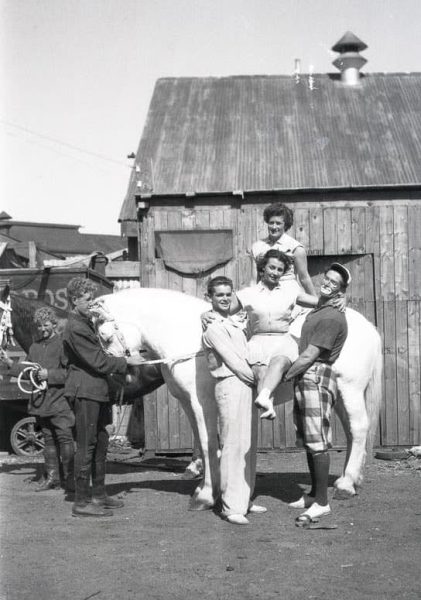
THE RIDING ST LEONS C. 1950: PEGGY ST LEON HELD BY BROTHERS LEO AND JOE, SISTER STELLA BEHIND. [IMAGE COURTESY RASHIDA JOSEPH, VIA ‘THE PENNY GAFF’.]
The ‘penny gaff’ was once London’s most popular form of entertainment. Cheap—the price of a penny—with the surprise or ‘gaff’ waiting behind canvas sidewalls, these outdoor equestrian shows birthed the modern circus as it is known today.
RAHS councillor and circus historian Mark St Leon has dedicated some 50 years to recovering the overlooked history of Australia’s circus and travelling show people, and is the author of Circus: The Australian Story (Melbourne Books, 2011). His new website, ‘The Penny Gaff’, contains a wealth of information and resources about Australian circus history. Explore a timeline and comprehensive travel route database; browse the archives of circus ephemera, portraits, film, and more; find out if your own ancestors were involved in show business.
‘The Penny Gaff’ also highlights the history of the St Leons : one of Australia’s original circus families.
Follow the long and winding road of Australian circus history here .
References:
‘Philip Astley’, Britannica, https://www.britannica.com/biography/Philip-Astley , accessed 4 March 2021.
Mark St Leon, The Penny Gaff, https://www.pennygaff.com.au/ , accessed 4 March 2021.
Mark Valentine St Leon, ‘Colleano, Con (Cornelius) (1899-1973)’, Australian Dictionary of Biography, National Centre of Biography, Australian National University, https://adb.anu.edu.au/biography/colleano-con-cornelius-9789 , accessed 4 March 2021.
Mark Valentine St Leon, ‘St Leon, Matthew (1826-1903)’, Australian Dictionary of Biography, National Centre of Biography, Australian National University, https://adb.anu.edu.au/biography/st-leon-matthew-13181 , accessed 4 March 2021.
Mark Valentine St Leon, ‘Wirth, May Emmeline (1894-1978)’, Australian Dictionary of Biography, National Centre of Biography, Australian National University, https://adb.anu.edu.au/biography/wirth-may-emmeline-9158 , accessed 4 March 2021.
Ruth Teale, ‘Burton, Henry (1823-1900)’, Australian Dictionary of Biography, National Centre of Biography, Australian National University, https://adb.anu.edu.au/biography/burton-henry-3123 , accessed 4 March 2021.
Don't miss a post. Subscribe below to receive a round-up of the week's content.
Please check your email inbox or spam now and click the link to confirm your RAHS blog post weekly round up subscription. Thank you.
Submit a Comment Cancel reply
Your email address will not be published. Required fields are marked *
Save my name, email, and website in this browser for the next time I comment.
Submit Comment
- Aboriginal History
- Affiliated Societies
- Australian History
- Member’s Posts
- NSW History
- Women’s History Month
- International edition
- Australia edition
- Europe edition

'Unadorned, gritty, unpretentious': how Australian circus went global
Adelaide’s Gravity and Other Myths push the limits of the human body and show why local circus is far from being a sideshow
T he converted warehouse in the inner west of Adelaide has none of the glitz and glamour you would expect of one of Australia’s most successful circus companies. As Gravity and Other Myths (Gom, to the artists) rehearse their new production, industrial air-conditioning whirls to override summer outside. An inopportune metal pole is shielded by a pool noodle. An artist climbs a ladder to re-tape plastic sheeting against a window to keep the room dark.
On the mats, eight acrobats experiment with new skills. Often, they fall.
“What do you call that one?” yells director Darcy Grant. “Sketchy?” comes the response.
They try, and try again, until: “Beautiful!”
This isn’t a slick operation. It is fresh and scrappy. Out of Chaos will be the company’s second work to premiere at the Adelaide festival . As it is in rehearsal the company is also in New York with A Simple Space.
When that show premiered in 2013, it was performed in an abandoned cinema , lit by household lamps operated by the cast. Now, until 24 February, it’s playing off Broadway. Not bad for a company created by seven teenage friends.
“Most of us didn’t think we were going to have [circus] as a career,” says Jascha Boyce, a founding member and acrobat. Creating a show for Adelaide Fringe is something of a rite-of-passage for young people in Adelaide, so on graduating from high school – and from the youth circus school Cirkidz, where they fell in love with the artform – they created Freefall. It was, says Lachlan Binns, “really about hanging out with your mates.”

Freefall won best circus at Adelaide Fringe in 2010, and the same at Melbourne Fringe the next year. But even during a national tour in 2013, Gom still felt as though they were on a youthful but short-lived adventure. Their tour abroad to Edinburgh fringe, Boyce says, would be “our last hurrah: one big trip overseas”.
The plan, Binns says, was to grow up after that. “We do Edinburgh, and then maybe travel, and then live the rest of our lives.” But in Edinburgh they met international theatre agent Wolfgang Hoffman , who offered them representation.
They’ve been touring non-stop since.
Rachel Healey, co-artistic director of Adelaide festival, says there is a “fantastic history of Australian circus and physical theatre [going out] into the world,” from large companies like CircusOz down to duos like Acrobat .
The “overnight success” narrative of Gom obscures what in reality has been a “long-term commitment” to the form, “over two, three, four or more decades,” she explains.
Festival directors get to travel the world to taste-test productions that could travel to their cities, and Healey says circus is a genre that speaks clearly to the place its from. Australian companies, for instance, tend to have “an unadorned, gritty, unpretentious quality, [and a] great sense of humour,” while French companies can be “dangerous, and so outrageous”.
“The fact that we can even talk about the practice in each country speaks to the fact that there is such a massive appetite around the globe. The form can be so diverse and so any company can be so idiosyncratic, even though it’s all the same genre.”
But while Gom is based in South Australia, some consider Brisbane the spiritual home of Australian circus. David Berthold, artistic director of Brisbane festival, lists Briefs Factory, Casus, Company 2, and Circa as among the most internationally successful companies from his city. With multiple shows playing across Australia and Europe throughout 2019 , Circa, he says, is “probably the best circus company of its type in its world.”
For Berthold, there are three facets to Australian circus that makes these companies so successful: “One, the high level of skill; two, a really high level of conceptual ambition. And there is an enormous friendliness on stage that oozes into the audience.”
Sitting in theatres in Edinburgh, watching Australian companies alongside international audiences, Berthold says patrons are “flabbergasted.”
“Even more so than Australian audiences, because Australian audiences, wonderfully, have got used to it – which in turn pushes the companies.”

For Boyce, Australian circus is defined by its “focus around a kind of honesty and the group energy on stage. Really being ourselves on stage, and at the same time really pushing the limits physically of what is possible.”
Binns says it’s also in how performers relate to their audiences: “We look people in the eye and connect directly with them.”
Much of Gom’s appeal is the way the company builds competition into performance: who can hold a handstand the longest while being pelted with plastic balls? Who can perform the most standing back-tucks in a row?
“Healthy competition!” Boyce laughs.
While Boyce and Binns still perform – in August, they played to the 2,900-seat Royal Festival Hall in London, with Backbone – but Out of Chaos will be the first time they assistant direct from offstage. On the mats, they lean over conversations with acrobats using cue cards to map out a structure; at the front of the room they talk to designers with the physical language of performers, arms punctuating to represent movement of the lights. What started as a youthful lark has become a multifaceted, internationally regarded career.
In March, the whole company of 29 artists – including five of the original company – will be together in one city for the first time. No longer just a group of friends from Adelaide, the company now pulls acrobats from across Australia and sends them across the world.
They never thought about moving the company to Berlin?
“We’ve spoken about it!” jokes Boyce.
“No, Adelaide’s home,” says Binns. “South Australian pride.”
- Adelaide festival
Most viewed
- Account Details
- Newsletters
- Group Subscription
Australia's 'big tops' a model for 21st-century circuses
Traditional traveling shows have moved with the times and growing restrictions
CESSNOCK, Australia -- The circus is coming to town! Bold posters and huge inflatable clown faces announcing the arrival of the circus evoke childhood memories: the roar of the lions, the crack of the ringmaster's whip, the thunder of horses galloping around the ring, the gasps of the audience as the trapeze artists swing through the air, the slapstick humor of the clowns as they keep the crowds laughing between acts.
Except that it will not be like that. The modern Australian circus is very different from its 19th- and 20th-century predecessors. Forced to contend with competition from theme parks, on-demand electronic entertainment and changing attitudes to the use of exotic animals, the traveling circus today takes a different tack.
Australia grapples with explosive history of frontier wars
Australia's black opal fields lure dreamers and prospectors, in australia, multicultural means multireligious, 'black cockatoo' shines light on australia's dark history, time to listen to australia's indigenous voices, australia's first 'dark sky park' draws in stargazers, latest on life, gastronomy becomes key draw for high-end travelers to japan, australians cozy up to japan-influenced 'japandi' design, photographer documents disappearing face tattoos of myanmar's chin women, sponsored content, about sponsored content this content was commissioned by nikkei's global business bureau..
Nikkei Asian Review, now known as Nikkei Asia, will be the voice of the Asian Century.
Celebrate our next chapter Free access for everyone - Sep. 30

NOW SHOWING: PENRITH NSW. PACEWAY, MULGOA RD. FRIDAY 3rd MAY TO SUNDAY 12th MAY COMING TO: CASTLE HILL NSW. SHOWGROUNDS FRIDAY 7th JUNE TO SUNDAY 30th JUNE ROSEHILL NSW. SCHOOL HOLIDAYS CNR JAMES RUSE DRIVE & GRAND AVE. FRIDAY 5th JULY TO SUNDAY 28th JULY PLEASE NOTE IF MAKING A BOOKING AND YOU WOULD LIKE TO SIT TOGETHER WITH ANOTHER GROUP YOU MUST BOOK UNDER THE SAME NAME & PHONE NUMBER TO BE SAT TOGETHER. FOR ALL ENQUIRIES OR TO MAKE A PHONE RESERVATION CALL 0418247287. ALSO FOR DISABILITY OR COMPANION CARDS DO NOT BOOK ONLINE PLEASE CALL 0418247287.

The show is approximately two hours, including interval

Children 2 and under are free if they can sit on your lap
Children 3-15 are included in the Child pricing above
16+ require adult tickets
Get in Touch

Thanks for submitting!
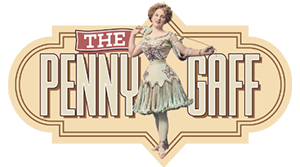
A long & winding road: The story of circus in Australia
By mark st leon.
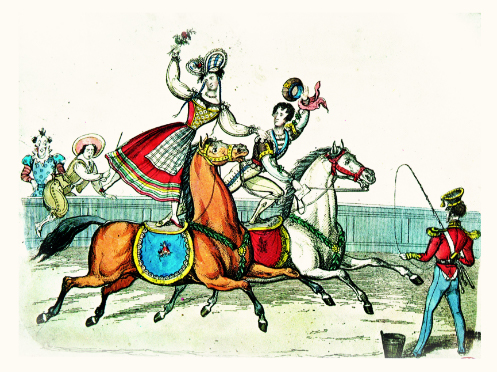
The circus was once one of Australia’s most popular forms of entertainment. Then came cinema, then television, and the circus all but died, in standard as well as strength, not to mention public esteem. Then some people began to re-think the idea of circus. It was not so much that circus was an inferior form of entertainment, it was just that it had been let down by economics and its apparent inability to accommodate changing social values. Judging by the growing storm of circus activity taking place around Australia today – countless circus groups, a federally-funded national circus school and regular imports and exports of circus activity in one form or another – circus is finding a new meaning and relevance. Circus in Australia lives and, from all appearances, has an exciting future. It also has a rich past.
In colonial and early 20th-century Australia, the travelling show was the practical solution to a fundamental economic problem: how to provide a small and widely-distributed population with access to popular entertainment. From the early 1850s, travelling entertainers delivered to Australians an extraordinary diversity of culture – popular, high and low – such as: opera, minstrel, photographic, magic, bellringing, gospel singing, boxing, menagerie and carnival, to name a few. However, the earliest demonstrable example of an Australian travelling show, and the most enduring, was the circus. The colonial popularity of horses and horsemanship, wrote Richard Twopeny in 1883, accounted for ‘perhaps the most critical and appreciative circus audiences in the world’.
The modern circus crystallised in London from 1768. Open-air displays of trick horsemanship given in a field called Ha’penny Hatch on London’s southern outskirts began to assume the form that we today associate with the circus. Crucial to these developments was a former cavalryman and veteran of the Seven Years War, Sergeant-Major Philip Astley. Astley (d.1814) combined displays of horsemanship with those of clowns, ropewalkers and gymnasts. By 1779, he had enclosed these displays within a permanent venue, near the south side of Westminster Bridge, which he named Astley’s Amphitheatre. This new genre of entertainment was popularly known around London as ‘the circus’ and the name stuck. While the Roman circus and the circus of modern times do share some features, the term ‘circus’ was 18 th century London vernacular to describe the large, open-air, circular riding tracks used by recreational riders, traces of which remain today in thoroughfares such as Piccadilly Circus.
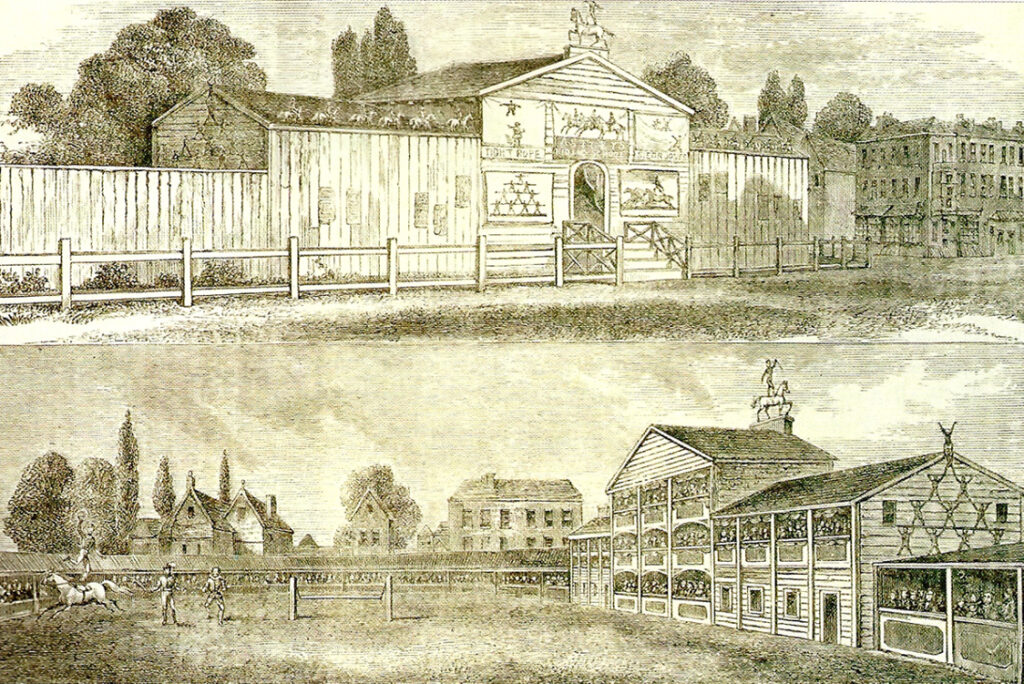
Although destroyed by fire several times and rebuilt, Astley’s Amphitheatre remained a major international venue for circus long after its founder’s death. The establishment reached the peak of its fame in the years 1825-41 under the management of the superlative horseman, Andrew Ducrow (1798-1842). Ducrow raised the spectacle of circus riding to an art form. His exquisite equestrian-based pantomimes and spectacles were imitated in circuses throughout the British Isles, on the Continent, in the new United States and in the new colonies of Australia.
The concept of the modern circus was still a new genre of entertainment when The First Fleet sailed in 1788. Indeed, we may speculate that many of the Fleet’s human cargo had witnessed, or were at least aware of, the delights of Astley’s. But organised popular entertainments were not among the priorities of a penal settlement. Sydney and Hobart Town were not served by regular theatre performances until the 1830s and then only with difficulty. The ropewalkers, gymnasts and equestrians who made occasional appearances as early as 1833 proved transient. Some 60 years passed after the arrival of the First Fleet before the elements necessary to launch a colonial circus industry – bureaucratic largesse , entrepreneurs, performers, audiences and prosperity – fell into place. Of the few settlements along Australia’s coastline, Launceston held the least promise as the foundation place of Australian circus. In 1847, this minor seaport held a population of only some 10 000, most of whom served the town’s penal purpose in some or another. Nevertheless, the location gave birth to the first comprehensive and successful demonstrations of colonial circus activity and, with it, the launch of a colonial circus industry.
There, in 1847, a Devonshire-born equestrian, horse dealer and publican named Robert Avis Radford (1814-65) pioneered the first successful circus in Australia and, with it, a continuous Australian circus tradition. This Astley’s ‘on a limited scale’ was a building of simple construction – presumably timber, iron and canvas – located in the yard of Radford’s Horse & Jockey Inn in York Street. It opened on the evening of Monday, 27 December 1847. With a little company of performers, some of whom were former convicts, Radford presented feats of horsemanship, dancing, vaulting, gymnastics, acrobatics, clowning and equestrian burlesque. The features of Astley’s Amphitheatre and the equestrian art of Andrew Ducrow were thus transposed, on a miniature and probably rougher scale, to this most distant point on the globe.
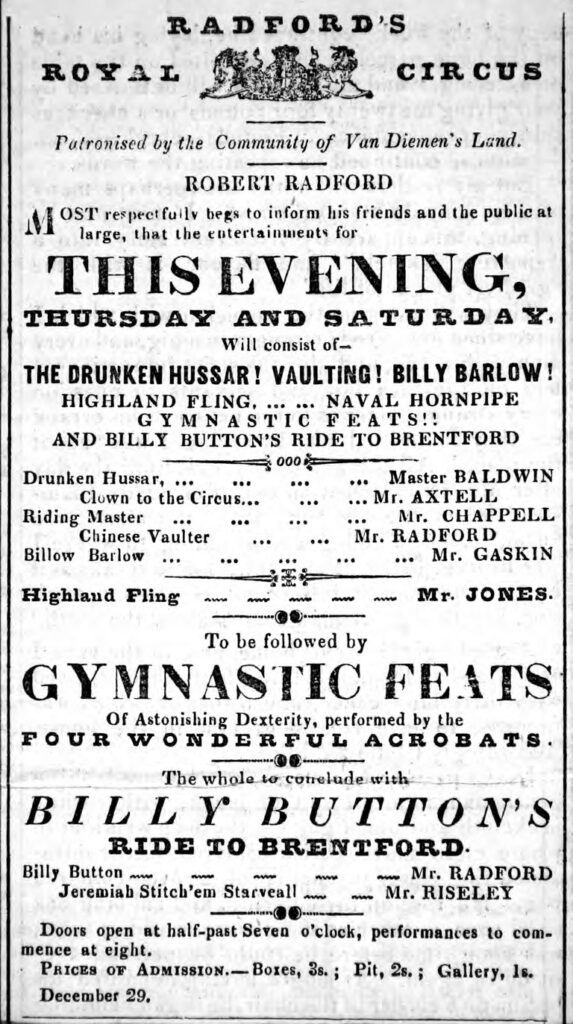
Following Radford’s example, colonial circus exhibitions were soon given in amphitheatres of modest descriptions in Port Phillip, Maitland, Singleton, Sydney and Adelaide in the years leading up to the first gold rushes. From these early establishments were derived the travelling circus troupes that traversed the eastern colonies to deliver equestrian, acrobatic, tumbling, clowning and tightrope performances to audiences in city, town and bush
From Sydney in February 1851, Henry Burton, a professional English circus man, took to the road with Australia’s first peripatetic company. Reaching Maitland, the discovery of gold on the Turon soon deprived him of an audience. He and his troupe then followed, with packhorses, an ill-formed road via Mudgee to reach the diggers on the new goldfield. For a time, the gold of the diggers focussed and sustained colonial circus activity at places such as Sofala and Ballarat. Golding [known professionally as ‘James Henry’] Ashton (1820-89), who gave his first Australian appearances as ‘the renowned British horseman’ in Radford’s in 1848 and opened his own amphitheatre in 1851 , was travelling the New England goldfields with his tented circus by the summer of 1852-53. Ashton’s descendants remain active in Australian circus today and conduct, arguably, the oldest circus companies in the English-speaking world.
Another of Radford’s performers, the London-born acrobat, equestrian and ropewalker John Jones (c.1826-1903) was a witness to the events leading up to the Eureka Stockade at Ballarat at 1854. Indeed, the bandsmen of Jones’ Circus were commanded at gunpoint to serenade the diggers as they worked to construct the stockade. Jones later (1865) adopted the professional -and less prosaic- nom d’arena of St Leon.
From the late 1870s until the early 1920s, St Leon’s was one of Australia’s major circus companies and, by the early 1900s, the family was well-represented in American circus as well.
After 1854, the circus routes began to extend beyond the familiar precincts of the eastern settlements and the interior goldfields. The early circus proprietors found, as had the wandering minstrels of medieval Europe and the circus men of the American frontier, that it was easier to change audience than repertoire. To change audience, they had to change location. Moving beyond the confines of the amphitheatres, the Australian circus acquired the characteristics of mobility with which it is today identified – tents, touring and transportability. Light, flexible tents replaced the early cumbersome structures called booths that had to be erected, dismantled and transported between each location visited.
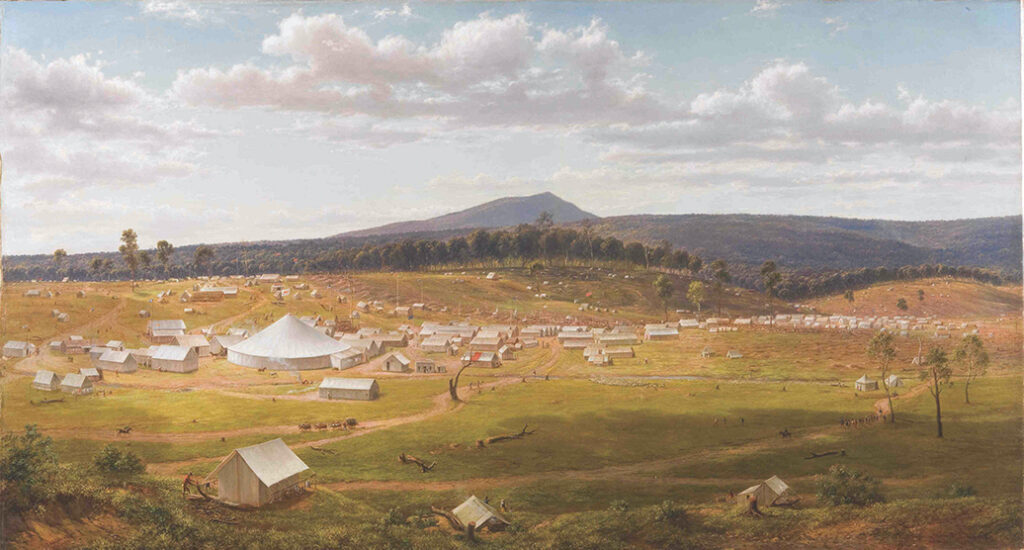
Tented circuses reached Moreton Bay [now Brisbane] in 1855 and Adelaide in 1856. It took longer for the circus to reach Fremantle (1869), Cooktown (1889) and Darwin (1914). Not until the 1890s, in the wake of the fabulous gold rushes, did the larger circus companies of Australia’s eastern seaboard regularly visit Western Australia. Advance agents travelled ahead to advertise the circus along its route. A theatrical licence, usually costing a guinea and good for 12 months, was required in each colony visited.
There was something peculiarly appropriate about the circus in an Australian context. On outward appearances, the circus reflected some of the most pervasive features of Australian life: on the one hand, it eschewed matters of intellect; on the other, it reflected our pursuit of athletic glory in any form and irreverence for pretentiousness and authority. But the worst of circus also concealed objectionable practises such as the ‘adoption’ of young children – often illegitimate or abandoned – into indescribably harsh apprenticehips as circus performers.
In many respects, Australia’s itinerant circus people of the late 19th and early 20th century were explorers who constantly pushed at the frontiers of human settlement and faced the natural challenges of drought, fire and flood; and the lack of roads, bridges and communications that we today take for granted. The smaller circuses went to extraordinary lengths to reach people in the most remote areas of the bush and well away from the beaten track, the shearers, miners and the railway construction gangs. Early circus proprietors did their best to identify with these people of the bush by generously supporting appeals for hospitals, schools, churches, orphanages, Masonic halls or other buildings of civic importance in the towns they visited. Even the bushrangers tended to take a kinder view of a circus on the road preferring to wave it through rather than bail it up.
The circus was also a highly popular entertainment throughout the United States. The first circuses reached California in 1849 and within a few years one circus troupe, J A Rowe’s North American, had crossed the Pacific to Melbourne where Rowe erected a ‘commodious’ pavilion and played in the gold-stricken city for two years. After the interruption of the Civil War (1861-65), the completion of the transcontinental railway (1869) and the regularisation of trans-Pacific shipping services (1873), the ‘fabled land’ of Australia once again claimed the imagination of American circus men. Between 1873 and 1892, a steady stream of American circus companies, including the largest, visited Australia. The development of colonial rail systems facilitated their tours. The parade of Cooper, Bailey & Co’s Great International Allied Shows – the lineal ancestor of the later Ringling Bros and Barnum & Bailey’s Combined Shows – through the streets of Melbourne, carnival style, aroused a sensation in 1877. Its caravans were gaudily painted and decorated with parables from the scriptures. This was the ‘great moral show’, the one patronised by the American clergy, the circus that did not show on a Sunday.
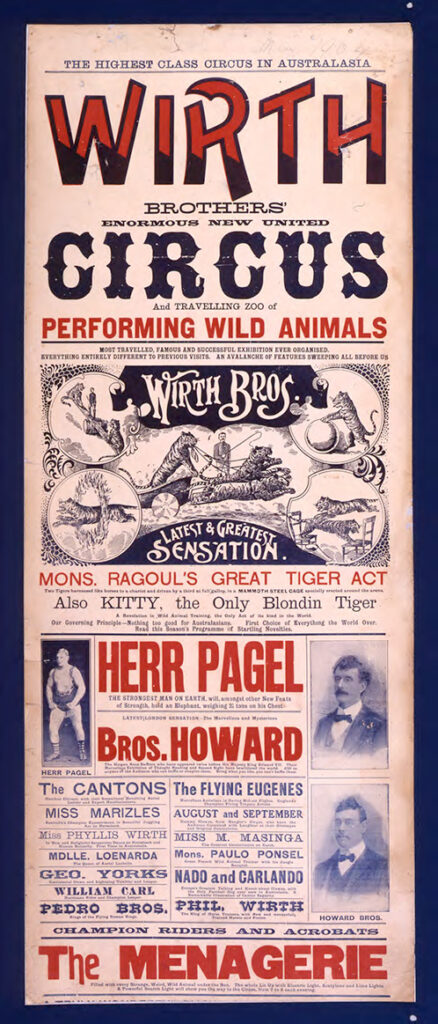
The largest Australian circuses did their best to emulate the American examples. Visiting Wollongong in 1883, St Leon’s Circus boasted ’150 men and horses’ – counted as one figure, such was the colonial esteem in which the quadruped was held – and a parade more than half-a-mile in length. By the close of the 19 th century, FitzGerald Bros and Wirth Bros toured the six states of Australia and New Zealand by rail and steamer along standardised routes, with imported companies of artistes, menageries of wild animals, large bands of professional musicians and lavish promotion. In 1901, FitzGerald Bros Circus comprised 112 people and was conveyed on 34 rail carriages. After the co-incidental deaths of the FitzGerald brothers in 1906, continents apart from each other, Wirth Bros was left as Australia’s largest circus company, a position it held until its final closure in 1963.
Australia nurtured some of the great stars of the international circus in this era. Two artists in particular deserve mention, although largely forgotten in their native land. These were the superlative equestrienne, Bundaberg-born May Wirth (born May Zinga, 1894-1978), an adopted daughter of the Wirth family; and the Indigenous tightwire dancer and acrobat, Narrabri-born Con Colleano (born Cornelius Sullivan, 1899-1973), whose family started out with its own circus from Lightning Ridge in 1910.
By the 1920s, Australian circus proprietors, long-accustomed to the free-spirited conduct of their business, were now faced with municipal restrictions governing parades and the posting of bills, while the cost of employing star acts and unionised musicians had soared. New forms of competition emerged in the form of the picture shows which reached the country districts from 1908, while cinemas were erected in the larger country towns from 1915. A motorised circus could move faster in this changing economic landscape. An advance agent travelled ahead of Ashton’s Circus in his own motor car in 1911 but motorisation did not become widespread in circus until the late 1920s and, as late as 1935, West Bros Circus crossed the Nullarbor Plain with horses and wagons. More than 20 motorised ‘road shows’ were active in the 1930s, such as Ashton’s, Bullen’s, Gill’s, Lennon’s and St Leon’s, while the largest, circuses, Wirth’s and Perry’s, were transported by rail.
In 1942, after war with Japan commenced, circus and other travelling show activity was severely curtailed. During World War I, circus horses had been commandeered by the army. Now, in World War II, the army requisitioned circus vehicles. As a morale-boosting measure, Wirth’s and Perry’s, were permitted to operate on a reduced scale for the remainder of the war.
After 1945, the circuses flowered once again, unfettered by wartime restrictions and able to ride upon the ever-increasing prosperity of post-war Australia. There were 17 circuses travelling the country by the mid-1950s. Then television was introduced. Wirth’s ceased operations in 1963 after 80 years of continuous travel and an international reputation to its name. The Wirth management placed blame for the demise on television although unpaid taxes, soaring rail costs and mismanagement contributed to the failure. The Bullen family, after more than 40 year’s touring throughout Australia and New Zealand, voluntarily pulled its 94-vehicle circus off the road in 1969 and re-directed its energies towards the establishment of wild animal safari parks.
By 1973, there were only four circuses of any consequence left to tour the continent: Ashton’s, Circus Royale, Sole Bros and Alberto’s, the last two conducted by descendants of the famous Perry family.

The public’s appetite for high quality circus entertainment was satisfied by the regular visits of the Great Moscow Circus and televised circus programs from Europe and America. But, despite the ascendancy of the electronic entertainment media, the ethos of an Australian circus tradition was not dead: it merely required updating.
Broadly speaking, Australian circus is today divided between contemporary groups on the one hand, and the more conventional family-based itinerant companies on the other. Some of the latter have been active for well over one hundred years, their programs dependant to varying degrees upon the presentation of animals, whether domesticated, exotic or wild. The former can be divided between the avant-garde ‘new wave’ companies, which are constantly pushing the meaning of circus to (and even beyond) conventional limits, and the youth-focussed community circus groups which are flowering all over the country in various forms and guises. The jewel in the contemporary circus crown belongs firmly to avant-garde group Circus Oz, based in Melbourne. Launched in 1978, this company now ranks as one of Australia’s major performing arts organisations.
Explore the collections
Dive into the archives.
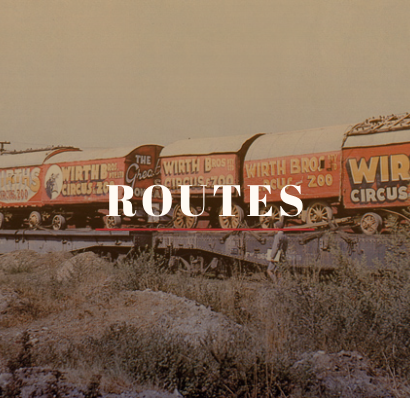
LOG IN REGISTER RESET PASSWORD
Circus projects pty ltd 2021 | terms & conditions | privacy policy | built by .

VIDEO : The circus extravaganza touring Australia
- X (formerly Twitter)
Circus 1903 is a dazzling celebration of a time when circuses were at their best.
- Arts, Culture and Entertainment
Stories from ABC News
At least 16 people injured and one dead following air strikes in ukraine's kharkiv.
Local community pause to remember two Australian brothers killed in Mexico
Civilians evacuate Rafah ahead of ground invasion
Government moves to fund students on university placements
Israel says it will launch ground offensive into Rafah

Entertaining Australia Since 1850

Ashton Entertainment comes from the longest serving performing arts organisation in Australia, the world renowned, Ashton Circus. With a 174 years of entertainment knowledge handed down through 8 generations, Ashton Entertainment are proud and privileged to carry on their rich legacy into the future.
Hire Us for Your Next Event
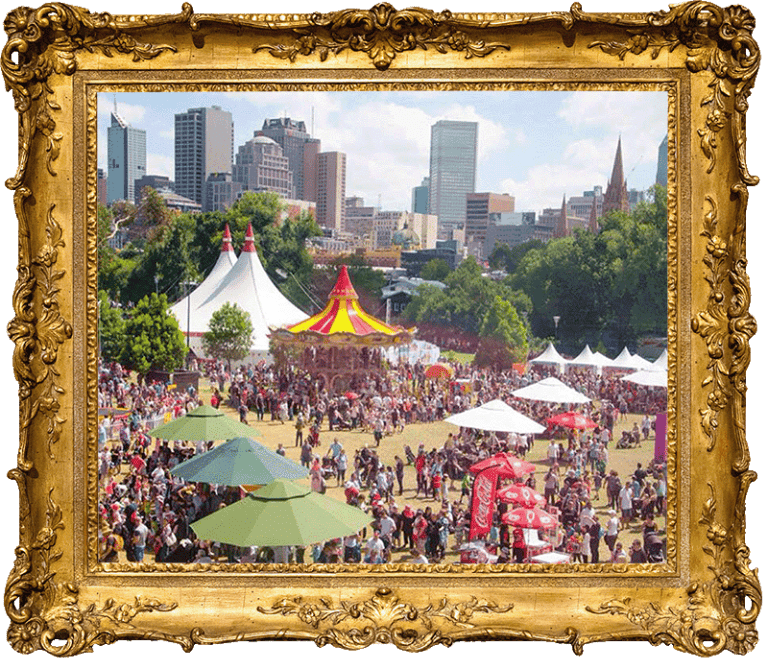
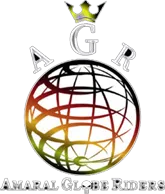
Globe Riders and FMX Stunt Show!
Their gravity-defying riding inside the mesh sphere and above will not only stun the audience, but will have them holding their breath long after the show is over.

What Our Audiences are Saying...
Thanks for the great show! Kids and I had an excellent time!
You guys have done amazing! Thanks so much for a wonderful time! Esther is still raving about the acrobatics and Ollie is still performing the telescope routine! Good luck!!!
Fantastic night and fantastic acts. Thanks for coming to Redland Bay! My 6 year old daughter was memorised and wants to learn to do the aerial silks.
The most amazing performers that draw the audience in from start to finish. HIGHLY RECOMMENDED Show.
AH-MAY-ZING!!! Job well done tonight guys. brilliant…Loved every second of it.
Saw your show tonight, loads of laughs, fabulous night out with the family!!! Thank you so much and see you all next time!!!
Just been to see you guys at Mudgeerabah…you guys are the best multi-taskers out!
I went tonight with my two kids to the Capalaba show, have to say from ringing yesterday to making a booking really lovely conversation with the lady who I’m sure was the MC tonight, to having my kids laughing lots and loving Ziggy, to watching the breathtaking Chantelle until the very end of the show I couldn’t fault a thing and highly recommend this circus to all, thank you for a great night will definitely be a return customer!!!
Just wanted to say thank you. We came to the opening night at Morayfield tonight i can’t remember how long its been since I’ve seen my daughter so excited and over the moon for the whole show. Thank you for keeping the circus going and the kid in all of us alive.
What an amazing night we had watching our very first circus! Thank you for putting on such a wonderful performance! Memories that will last a lifetime.
On behalf of my family, thanks for the Glen Innes performance tonight. I loved it. Would love to be able to know all the artists behind the music during the show because the music was awesome and would love to listen to again.
Thanks so much for Jan and your family for another amazingly, awesome and entertaining performance. You guys never fail to entertain and give us a few laughs along the way. Thank you as well to the performers for letting our boys have a photo taken with them at the end of the show this afternoon too. My boys are Ashton Entertainment groupies. They love you guys and so do we. Your family continues to entertain mine. for the last 40 years and still counting! Safe travels to you all to Sydney and we will see you at Capalaba.
Wow! Thank you so much for such amazing evening! Brought my 4 boys and had to drag the 14 and 12 year old who were not keen at all to be there…that all changed pretty quickly right on 7pm when the excitement began! What a wonderful experience! You were all brilliant! My boys haven’t stopped talking about it.
We would just like to give a BIG shout out to the Ashton Entertainment Circus Cast for your hospitality and friendliness towards ourselves and our 2 boys. Thank you for allowing them into your travelling community for the time period that you guys were in Redland Bay and showing them what entertainment is all about. The impression that we got from them after each visit was how kind and warm hearted you guys are. Also thank you for inviting us to your show. We thoroughly enjoyed every minute of the show and it was a GREAT pleasure to meet you guys in person.
Kids had a blast today at your show, was a fun filled afternoon. Thanks again.
Hi guys, would like to say how much we enjoyed tonight’s performance! I have 4 kiddies and they thoroughly enjoyed it. What a talented bunch you all are. Thank you for making it a wonderful night to remember!
The highlight of my life 60 years ago, was when Ashtons Circus came to our suburb, Kingsgrove NSW. Watched the parade down the main street, from my front yard. Jumped the back fence, into the paddock where the Big Top was located. Played with Jan Ashton and saw the circus countless times over the years. I still remember being enthralled watching Merv Ashton performing on the flying trapeze. A clown asking for a young lad to volunteer to ride a horse. Kneeling on the horse, he was put in a harness, rope attached above as he was bouncing up and down, he was pulled into the air, while his trousers were pulled down his legs! Would definitely be frowned upon today, but was so much fun at the time and the audience loved it. “Those were the day”.
Very enjoyable show at Redland bay today, both kids and adults enjoyed. Thank you, great fun. You are a talented team. Thank you.
What a fantastic group of people. Talented, happy and super professional. We had some guests travel in from Durnham Downs for the rodeo who had three young boys They planned to do the circus workshop but there was a mixup with the time. The Ashton Entertainment guys did a private workshop with the kids on the back lawn of Club Boutique Hotel Cunnamulla. How Amazing is that. Thank you Ashton guys made three little boys very happy!
Amazing show tonight, it was worth every cent spent. Can’t wait for next time you guys come around.
Absolutely amazing talent. Loved the show guys, definitely recommending it.
My family and I have just now returned from a performance at Ashton’s Circus. IT WAS AMAZING!!!! It was a total ADRENALIN RUSH!!! There were moments when my heart was in my throat. And I was left breathless. And the Clowns were so funny. I laughed until I almost cried. The performers are fearless. And their skills are mind blowing. We all thoroughly enjoyed every moment of the performance. And after the show, it was just a buzz for all of us to be able talk to all the performers. They were only too happy to talk to us all and take photos with the children and give them autographs. All of the staff of Ashton’s entertainment were friendly- old fashioned manners and friendliness are alive and well at their performances. When they come back next year, myself and my family will be there. We look forward to catching the show every time they come back to our area. For a great and affordable night out, do yourself a favour, grab the family or a group of friends and catch their show. You will not be disappointed. You will come away feeling as thrilled as we do. Don’t miss out, we booked by phone and picked them up from the ticket lady (really nice lady as well).
Took my girls to the circus tonight. It was amazing! We all loved it! What a very talented bunch of people! Would absolutely recommend it! As my 6 y.o said is was the “best night ever!”
Thank you to all the wonderful people at Ashton Entertainment for a fabulous night. My daughter is in awe of you.
Awesome entertainment, thanks for a great night!!!
Thanks so much for having us tonight the kids had so much fun. We’ve seen you guys a few times and we always leave satisfied! Thank you
We thoroughly enjoyed your show in inverell today. The kids went to bed totally exhausted but still talking about how clever you all were.
Wow this is a great show and I really recommend it. My elderly father attended and nearly fell off the chair as he was laughing so much. The commical antics of Squiggy the Clown, Aerial Artistry of Chantel, the incredible High Perch and elgant contortion were just a few acts which just keep you captivated. A fantastic family show!!! Come and support them!!!
We booked our show for a seating of 8 on the very 1st night on Friday the 1st of August 14′ and it was absolutely great such an enjoyable night the clowns were crazy n cute and the girls doing trapeze were breath taking …. have watched alot of footage since on youtube and this also takes my breath away the absolute talent over 7 generations is FANTASTIC!!! BIGGEST Thumbs up from the Edwards Family !!
Was fantastic thank you. The kids loved Squiggy! My 9 year old loved the history, we looked it up on your website while waiting and seeing grandparents helping younger ones. A credit to you all. Thank you for the fantastic experience.
It is such a pleasure to get these memories of the Trix Circus students. Thank you Chantel Ashton Rodriguez for sharing these wonderful memories. Thanks also to your family circus for giving these talented students a chance to perform in a real circus and for giving them a great experience on their journey in our beloved circus industry. We all hold our collective breaths hoping that Covid-19 will ease up and allow us to get back to do the things we love to do, and that is to entertain. Do what you need to do to get through this safely, we all want to get back to work!
This was such an amazing show. Well done everyone!
Great show tonight my 1 and 3 year old specially loved it. See you next time.
We had a wonderful time at the circus. Thanks so much to Ashton Entertainment and the lovely Ashton-Rodriguez family. All the kids left with prizes and were very proud of their autographed programs. What an amazing experience!
Every now and then, an ex-student will share a picture of an act that I taught them and it is wonderful being reminded of those times during their journey in circus. Thanks to @Chantel Ashton Rodriguez for sharing all these wonderful memories and to your family for giving this group of wonderful students to have a chance of performing in your circus. I really enjoy seeing how far many of them have come in the circus industry since these pictures were taken.
Follow us on Instagram!

Tour Dates: 2024 TOUR: Hudsons Circus has expanded!! Two great shows in Two great locations ! ______________________ Hudsons Circus Red Show: AIRLIE BEACH - 1st - 5th May TOWNSVILLE - 9th May - 2nd June Hudsons Circus Gold Show: SANDGATE - 18th Apr - 6th May IPSWICH - 10th - 26th May PLAINLAND - 30th May - 9th June

WELCOME TO HUDSONS CIRCUS - Australia's Daredevil Circus !! THE CIRCUS WITH THE PERFORMING ANIMALS!
Hudsons Circus presents a 2 hour traditional style Circus
with a modern twist featuring
‘Edge of your seat Daredevils, Hilarious clowns, aerial acrobatics and beautiful animal acts’ in a fast paced show for the whole family !

Hudsons Circus
Celebrated our, 10th anniversary tour in 2023.
The circus with the performing animals and daredevil performers toured 20 towns and performed 313 shows on our 10th A nniversary tour in 2023 across NSW and Queensland.
In 2024 Hudsons Circus has expanded and we have two great shows running at the same time in two great locations!
We have different performers and
several different acts in each show!
Ticket for LUZIA in Melbourne, VIC at Under the Big Top, Flemington Racecourse
LUZIA is inspired by the people, places, and stories that define Mexico. Take a journey through a dream of Mexico, from the folklore of old to the urban landscape of today.
Standard Group Offer
Save up to 25% on 10+ tickets (excl. Sat) Click below or call (02) 9037 6563
Group Offers
Whether for business or for fun, we offer different creative options to host your group of 10 or more.
Fan Favorite Videos
Watch awe-inspiring show footage and behind-the-scenes videos on our CirqueConnect content hub!
A waking dream of Mexico
LUZIA is inspired by the people, places, and stories that define Mexico. Take a journey through a dream of Mexico, from the folklore of old to the urban landscape of today. LUZIA takes you to an imaginary Mexico, like in a waking dream, where light (“luz” in Spanish) quenches the spirit and rain (“lluvia”) soothes the soul. With a surrealistic series of grand visual surprises and breathtaking acrobatic performances, LUZIA cleverly brings to the stage multiple places, faces and sounds of Mexico taken from both tradition and modernity.
LUZIA takes you on a surreal trip through Mexican locales and cultures. Step behind the scenes!
Meet Eric, one of LUZIA's star clowns.See what it's like to live as a Cirque du Soleil artist!
Oksana gracefully soars through the air; meet one of our aerial artists!
Gravity means nothing to Benjamin! Meet one of LUZIA's aerial strap artists.
LUZIA's prop and set designer discusses how Mexico City continues to be a source of inspiration.
Behind the Scenes of LUZIA!
Practical info.
61 1800 573 122 61 735 204 239
How do I buy tickets for LUZIA?
Are reduced mobility tickets for luzia also available online , are there group ticket rates for luzia, at what age must children have a ticket for luzia, how do i buy tickets for luzia without a credit card, which credit cards are accepted to buy online tickets for luzia.
Official Partners
RI’s curious history with traveling circuses as Ringling Bros. and Barnum & Bailey returns
From city ordinances banning exotic animals to a tragic accident involving aerialists, circus acts have left their mark on rhode island.
PROVIDENCE – The circus is coming to town.
After a six-year hiatus, Ringling Bros. and Barnum & Bailey is bringing its traveling show back to Providence’s Amica Mutual Pavilion this weekend. The last time the circus came to town was also its last performance before folding its tent for five years and relaunching as a reimagined show last year.
This weekend’s shows promise an “immersive environment” with new technology. Of course, the acrobats, clowns, extreme BMX riders, trapeze artists and teeter-totters will be there. So will 20-year-old Skyler Miser, " Human Rocket ," who will fly 110 feet through the air above the audience after being shot from a cannon.
Rhode Island is no stranger to circus visits, but it has a complicated relationship with the traveling shows. Here are a few curious facts from the Ocean State’s circus history.
Rhode Island was the first state to ban bullhooks
Rhode Island has a soft spot for exotic animals. For evidence of this, look no further than the amusing tale of 11 escaped monkeys who wreaked havoc and captured hearts in Warwick in the late 1930s.
Perhaps because of this, it may be no surprise that Rhode Island became the first state in the U.S. to ban bullhooks. Also known as an elephant goad, a bullhook is a long rod fitted with a hook and a sharp metal tip. Trainers and animal keepers have used them to poke elephants in sensitive areas, according to Elephant Voices, a nonprofit. The practice drew sharp criticism from human rights advocates, who said it caused physical and psychological damage to the elephants.
Rhode Island happened to be the last place where Ringling Bros. and Barnum & Bailey included elephants as part of the show. The circus retired its elephant act about a month before Rhode Island banned the use of the devices in the state.
No exotic animals, please
Some Rhode Islanders love exotic animals so much that they have determined to keep them out, if possible. Last December, the Providence City Council approved an ordinance – later signed by Mayor Brett Smiley – prohibiting shows that use wild or exotic animals.
“It shall be unlawful for any person or organization to conduct, sponsor, walk, exhibit or operate a traveling show or circus that includes live wild or exotic animals on any public or private land within the City of Providence,” the ordinance says, though it makes exceptions for educational purposes and domestic animals.
Ringling Bros. and Barnum & Bailey has phased out all animals from its shows. Instead, the circus now travels with a robotic dog that performs tricks with a trainer.
A near-fatal accident leaves aerialists severely injured
The most dramatic moment in the circus history of Rhode Island was also the most tragic. On May 4, 2014, eight acrobats, tethered by their hair to a chandelier-like contraption more than 20 feet in the air, plummeted to the floor during a live performance of Ringling Bros. and Barnum & Bailey. They broke bones and suffered internal and spinal injuries.
The accident resulted in a lawsuit against the Rhode Island Convention Center Authority and its managing company. It was settled six years later, in 2020, for $52.5 million.
A look back: After a harrowing plunge toward death, circus aerialists rise back to life
The road to recovery was not easy. It was full of tears and setbacks. But one by one the former performers carved lives for themselves out of the wreckage of the accident.
"You need to fight for your life," said Widny Neves, one of the survivors. "You need to fight for something even better. You need to see that beyond that big, dark tunnel, there's light at the end. There is light.”
Bodies found in Mexico where Australian, US tourists went missing
- Medium Text
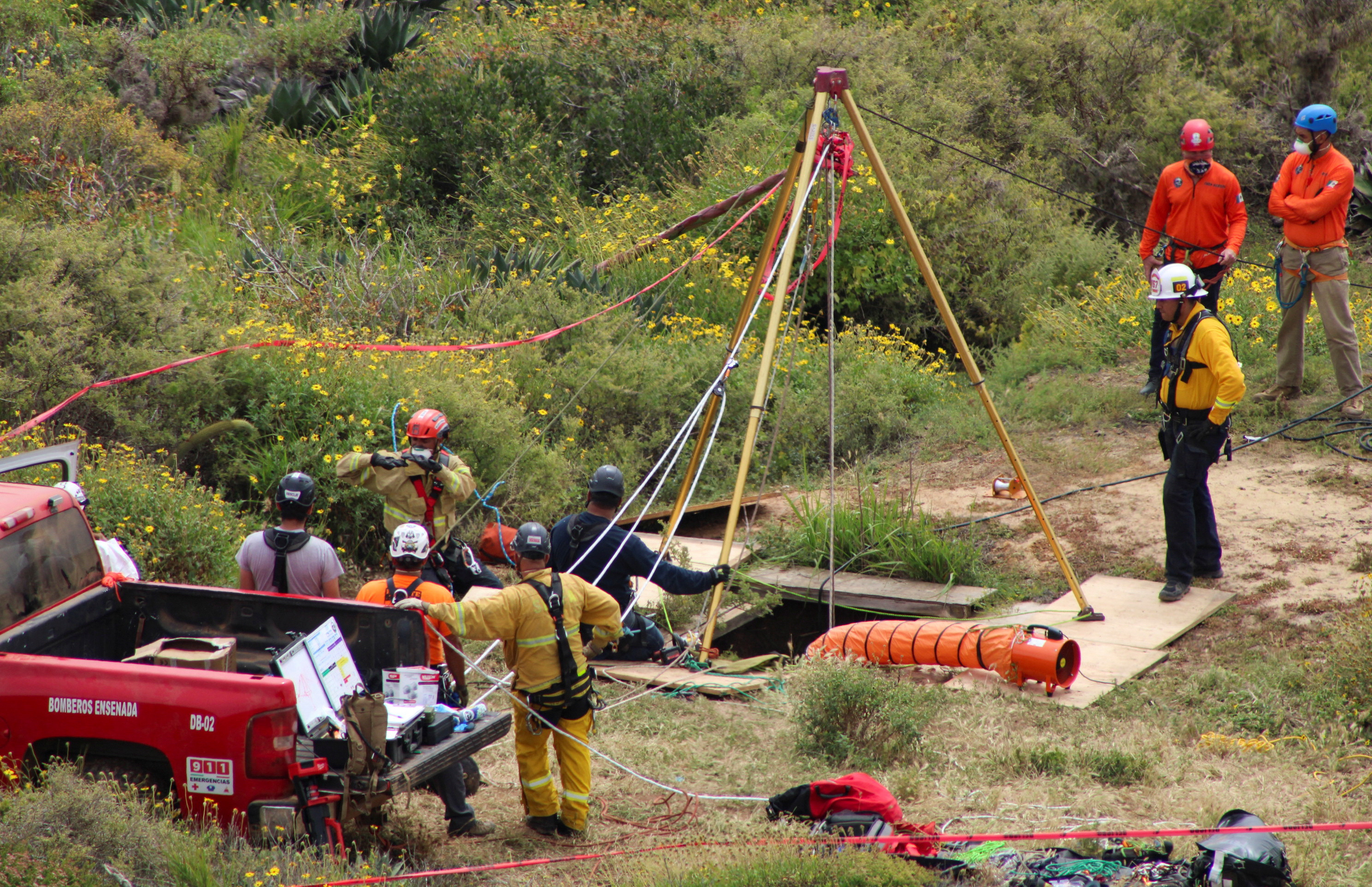
Sign up here.
Reporting by Lizbeth Diaz; Writing by Brendan O'Boyle; Editing by Stephen Eisenhammer, Sandra Maler and Sam Holmes
Our Standards: The Thomson Reuters Trust Principles. New Tab , opens new tab
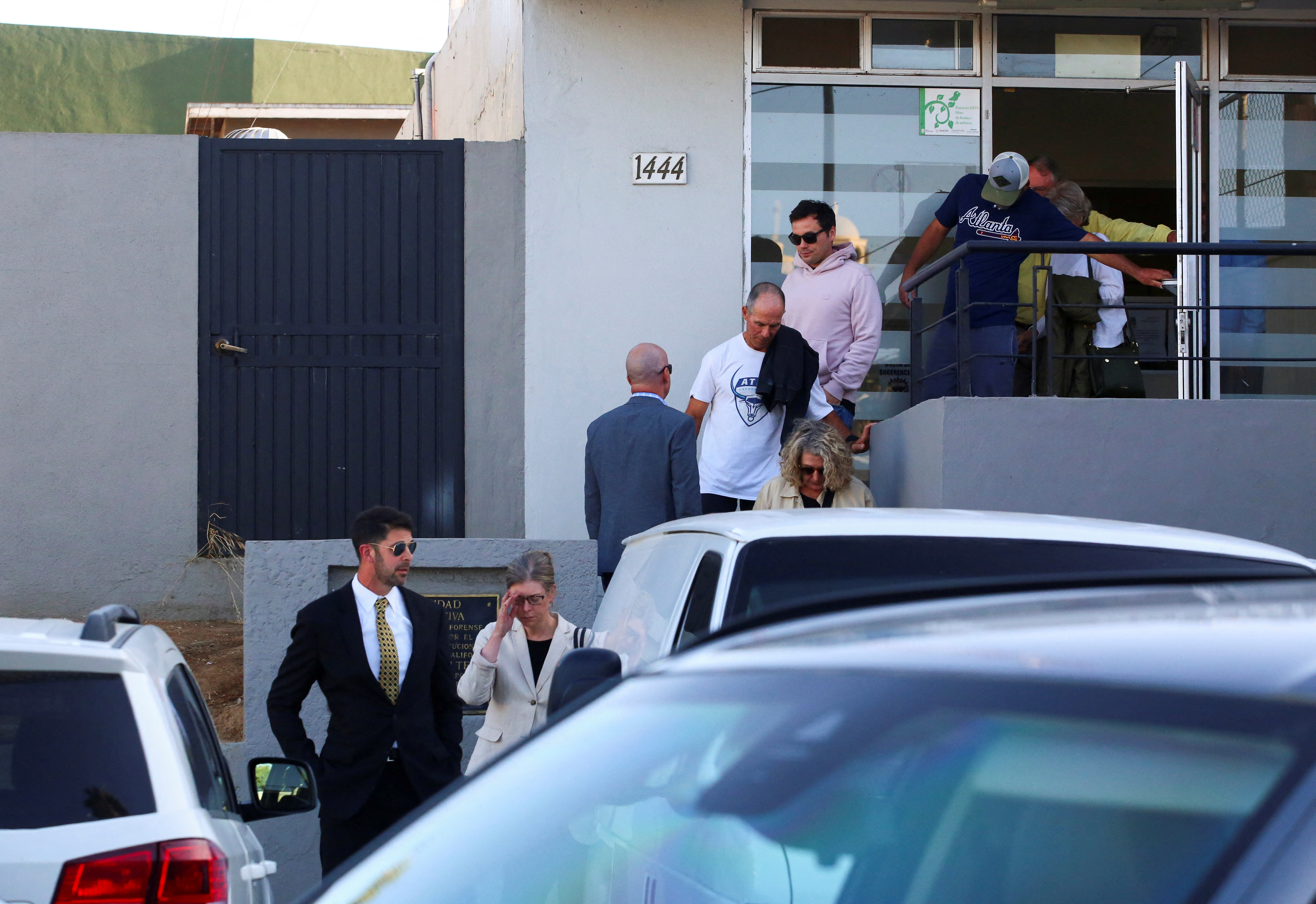
World Chevron

Gazans flee Rafah as Israel strikes city after evacuation order
Israel's military carried out airstrikes in Rafah, residents said, hours after Israel told Palestinians to evacuate parts of the southern Gaza city where more than a million people uprooted by the war have been sheltering.

Students in Belgium and the Netherlands occupied parts of the universities of Ghent and Amsterdam on Monday to protest against Israel's war in Gaza, joining international student protests that started on U.S. campuses.

IMAGES
VIDEO
COMMENTS
Wirth's Circus was Australia's largest and most prestigious circus company. For 80 years Wirth's was billed as Australia's own 'Greatest Show on Earth', and was a huge travelling circus with an international reputation. They embarked on significant world tours and were the first Australian circus to perform in England.
Wirth's, Australia's largest circus until it closed in 1963, a victim of the arrival of television and the public's changing tastes in entertainment, set up its big top on the south bank of the ...
Circus Oz has been travelling around the world promoting what is unique about Australia. ( 774 ABC Melbourne: Simon Leo Brown ) It has also been travelling around Australia making Australians feel ...
Wirth's Circus, also known as Wirth Brothers' Circus, was Australia's largest and most prestigious circus company for eight decades. [1] Billed as Australia's own 'Greatest show on Earth' (a reference to the slogan of the American P. T. Barnum Circus ), the travelling circus held an international reputation.
By the early 1900s, one of the most financially rewarding show routes ran almost the entire length of Australia's eastern seaboard, from Bega on the south coast of New South Wales as far as Cairns, on the coast of far north Queensland. The golden age of the circus lasted from the 1850s until the early 1960s. But by the 1920s the circuses were ...
The circus has a long tradition in Australia and it's a spectacle that has evolved over time. From childhood memories of colour, noise and excitement through to adult recollections of time spent enjoying the delights of a travelling circus, the pleasures circuses have offered generations of Australians are undeniable.
The Bells, now a sixth-generation travelling show family, have been touring Australia for a century, progressing from boxing tents to imported, top-of-the-range rides.
The circus is a rich and vibrant part of Australian cultural history that continues to flourish in many different forms today. Some of the most famous international circus stars of the twentieth century were Australian; at the height of the industry, 17 large circuses were travelling the country at once.
Webers Circus is an Australian travelling circus founded by Natalie and Rudy (Rüdiger) Weber in 2007 after dissolving a partnership of 13 years with Rudy's brother Harry who still runs the Weber Bros Circus in New Zealand. Natalie's mother is Janice Lennon of the Stardust Circus.
Circus/physical theatre company Gravity and Other Myths in rehearsal for their 2017 production Backbone. In 2019 they will debut a new work, Out of Chaos, at Adelaide Festival.
Australia's 'big tops' a model for 21st-century circuses. Traditional traveling shows have moved with the times and growing restrictions. Walison the clown of Hudsons Circus started out in his ...
By late 1908, the Gus St Leon family had returned to Australia and, at Liverpool, outside Sydney, formed Gus St Leon's Great United Circus, the main circus to carry the St Leon name until the 1940s. The 16-piece circus band, supplied with the latest rags and marches from America, was the envy of even professional brass bands.
Stardust Circus is a circus that tours in Australia. Its annual performance season lasts from January to late November, touring Australia from the remotest towns to the largest cities. The circus was established by the Lennon and West families, two circus families with tradition going back to the late 19th century.
Circus in Australia lives and, from all appearances, has an exciting future. It also has a rich past. In colonial and early 20th-century Australia, the travelling show was the practical solution to a fundamental economic problem: how to provide a small and widely-distributed population with access to popular entertainment.
Silvers Circus. A Melbourne entertainment option since 1976, Silvers Circus is often called "Australia's Greatest Circus" and offers visitors to Melbourne a big top show the city can be proud of. It undergoes constant innovation and modernisation, ensuring contemporary family entertainment. www.silverscircus.com.au.
W. Webers Circus. Wirth's Circus. Women's Circus (Melbourne) Categories: Entertainment companies of Australia. Performing arts in Australia. Circuses by country.
Circus historian Mark St. Leon claims the first known licence to 'perform dancing, tumbling and horsemanship' in NSW was issued in 1830.The first circus shows were presented in the fledgling theatres that sprung up in Australia's settler colonies, but within 20 years many small circuses were performing under canvas, travelling to the emerging colonies, and appearing as a regular feature ...
The circus extravaganza touring Australia. Posted Tue 26 Dec 2023 at 7:02pm. Watch. 3m 3s. Circus 1903 is a dazzling celebration of a time when circuses were at their best. Circus 1903 is a ...
About Us. Ashton Entertainment comes from the longest serving performing arts organisation in Australia, the world renowned, Ashton Circus. With a 174 years of entertainment knowledge handed down through 8 generations, Ashton Entertainment are proud and privileged to carry on their rich legacy into the future. Read More.
Hudsons Circus Celebrated our 10th Anniversary Tour in 2023! The circus with the performing animals and daredevil performers toured 20 towns and performed 313 shows on our 10th A nniversary tour in 2023 across NSW and Queensland.. In 2024 Hudsons Circus has expanded and we have two great shows running at the same time in two great locations!. We have different performers and
THE MUST-SEE INTERNATIONAL CIRCUS OF THE YEAR! For the first time in Australia, ZIRK! CIRCUS - The Big Top Spectacular is now playing in Sydney only until 11 August 2019. Combining the thrills and fun of Russia's finest circus traditions with the skills of today's daredevil heroes, ZIRK! is the best of international circus. Get tickets.
There have been many famous modern circuses since the first modern circus was staged by Philip Astley in London on January 9, 1768. Many are best known by the name of their principal owner. The following is a list of both circuses and their country of origin. For more information on circuses in general see Circus, or Contemporary circus, or for ...
Ticket for LUZIA in Melbourne, VIC at Under the Big Top, Flemington Racecourse. LUZIA is inspired by the people, places, and stories that define Mexico. Take a journey through a dream of Mexico, from the folklore of old to the urban landscape of today. Watch Trailer.
For many years, several travelling circuses kept elephants, but there are no longer any elephants performing in Australian circuses. Other animals used include horses, donkeys and dogs and less traditional species such as camels, alpacas and cows. A number of improvements have occurred in Australian circuses over the past 50 years, including an
Flip Circus. Based out of Texas, the Flip Circus is a touring show that brings the goods to various states. Featuring acrobatics, aerial, floor acts, comedy, magic, and more, this show settles comfortably under its bright red and white striped tent. For ticket and location information, visit Flip Circus.
PROVIDENCE - The circus is coming to town. After a six-year hiatus, Ringling Bros. and Barnum & Bailey is bringing its traveling show back to Providence's Amica Mutual Pavilion this weekend.
Item 1 of 3 Members of a rescue team work at a site where three bodies were found in the state of Baja California where one American and two Australian tourists were reported missing, in La Bocana ...